29 July 2020
By portermathewsblog
23 July 2020
from reiwa.com.au

With the recent building grants announced by the State and Federal Government, you might be feeling inspired to build your dream home instead of buying an established property.
If you are one of those people who took the plunge and bought a block of land, or maybe your bathroom just needs a facelift, then it’s time to start thinking about what the perfect bathroom means for you.
We spoke with senior building designer for Summit Renovations, Ashley Tunley about the bathroom design trends that have gained momentum in 2020.
“Bathrooms remain one of the most popular rooms in an Australian home to renovate. We spend so much time in them, so it’s important to make sure the design and layout works for everyone in the family,” Mr Tunley said.
Top emerging bathroom trends
Pop of colour
Don’t be afraid to inject a little colour and fun into your bathroom.
The perfect addition to a neutral bathroom is an unexpected pop of colour which will create a focal point, either with your tiles, basins or hardware – the choice is yours!

Tapware
Brushed tapware seems to be increasing popular. Wall mixers and wall mounted tapware in this finish really stands out against the splashback.
One trend we’re seeing no signs of slowing down is the use of black tapware, which continues to gain momentum when it comes to bathroom renovations.
Freestanding baths
Freestanding baths instantly turn your bathroom into a resort-style sanctuary and are very popular amongst those renovating when adequate space is available.
With many different styles and sizes from oval or rectangle to D-shape and round, there’s plenty of options to choose from.
.jpg) A bathroom built by Summit Renovations
A bathroom built by Summit Renovations
Walk-in showers
A walk-in shower provides a contemporary finish and with no door or minimal glass – it really is a showstopper when it comes to a bathroom renovation.
Not only is a walk-in shower safer for children and the elderly, it’s also much easier to clean. With fewer nooks and crannies, that means less dirt and mould that can accumulate.
It also allows for a shower with a floor-to-ceiling design which gives you more options for where you place the shower heads and tapware.
 A walk-in-shower by Summit Renovations
A walk-in-shower by Summit Renovations
What about materials and textures?
Use quality, natural materials for surfaces such as stone benchtops which remain a popular choice in the bathroom due its durability.
Textured wall tiles are a popular choice as not only do they add personality and life to a bathroom, but they also prevent condensation forming on your walls.
When it comes to your bathroom vanity, a great way to add texture and warmth is by adding feature timber laminate. This continues to be a popular material due to its variation in colours and tones and it offers a timeless look.
According to Mr Tunley, there is no such thing as a one-size-fits-all bathroom solution.
“If the design of your bathroom is carefully considered, there’s nothing stopping you from having the bathroom of your dreams,” he said.
Before you breathe life into your new bathroom, make sure you’ve read our ten tips for renovating your bathroom.
Comments (0)
13 November 2019
By portermathewsblog
via reiwa.com.au

Residential master bedroom designed by Meli Studio
Downsizing is a part of life, as well as part of your property journey. But, just because you are moving into a smaller space, doesn’t mean you have to downgrade on the visual appeal.
We spoke with interior design expert, Julie Ockerby of Meli Studio who specialises in sophisticated living for seniors nationwide, who said downsizing is the perfect opportunity to design your ‘forever home’ exactly the way you want it.
Here are Julie’s 10 tips to help you downsize in style, while making the most out of your smaller space.
1. Only keep the things you love
Downsizing gives the perfect opportunity to give away or even sell anything in your life that doesn’t make your heart sing.
It may well be that you’ll need to buy smaller furniture items anyway, so consider this as an opportunity to let go of tired old pieces and replace them with the furniture that you’ve always wanted, especially when you don’t have to worry about pleasing anyone but yourself!
2. Don’t be afraid to be bold
When picking fabrics for any new furniture, throws, bedspreads, curtains or cushions, don’t be afraid to go bold with colours and textures, as this can help bring smaller spaces to life.
To really future-proof your new abode, pick fabrics that are stain resistant and with waterproof backing.
3. Height matters
Make sure that any new furniture is at a height that suits you. Ensure your bed is not too low or too high, while sofas and armchairs should not be too low, for ease of access as you get a little older.
4. Give yourself space
To create a home you can live in for as long as possible, space is essential.
This may seem counter-intuitive when downsizing, but even though you’re probably losing two or even three bedrooms, make sure your rooms are not too small to allow good access around your bed, dining table, chairs and sofas. You’ll be especially thankful for this if you or your friends end up needing a walking stick.
 Julie Ockerby holding the fabric collection of her new range
Julie Ockerby holding the fabric collection of her new range
5. Deck the walls
One area you might need to edit a bit, but don’t need to cull dramatically, is your artwork.
Create a dramatic feature wall by covering one wall with your favourite pieces, potentially combining art from several rooms in your old house.
6. Avoid clutter
Clutter is the enemy of good interior design and easy living. Cluttered tables and shelves are harder to keep clean, easier to mess up or knock over, and can actually be confusing on the eye and thus the mind.
You’ll appreciate and enjoy having just your favourite trinkets on display – even if you have to rotate them every now and again.
7. Don’t slip up
Use non-slip tiles wherever possible. Definitely use them in the bathroom, but also consider the kitchen and laundry, where spills can quickly become just as much of a hazard as a wet bathroom floor.
8. Light up your life
Good lighting, especially in often neglected areas like the shower or the dressing space in front of your wardrobes, can make a huge difference to the functionality, aesthetics and safety of essential areas that are used daily.
9. Say no to sharp corners
This applies to all ages and can give you more room to move without worrying about bumping into any nasty corners. It’s also an especially handy tip for when visiting grandchildren are toddling around.
10. Spoil yourself
Finally, splash out a with just a bit of the financial equity you hopefully free up when downsizing on an interior feature you’ve always dreamt of but could never quite afford.
Perhaps it’s a top-of-the-line steam oven, his and hers vanities or a stunning statement piece of art.
Are you looking to downsize in Perth? See what’s for sale.
Comments (0)
15 October 2018
By portermathewsblog
via reiwa.com.au
 Affordability in Perth’s residential sales market improved during the September 2018 quarter, with house and unit prices softening marginally.
Affordability in Perth’s residential sales market improved during the September 2018 quarter, with house and unit prices softening marginally.
REIWA President Damian Collins said there was excellent opportunity for buyers and investors to take advantage of current market conditions to secure their next home or investment property.
“While the worst of the market downturn appears to be behind us, the results of the September 2018 quarter reveal conditions are favourable for buyers and investors,” Mr Collins said.
Median house and unit price
reiwa.com data shows Perth’s median house price should settle at $505,000 for the September 2018 quarter.
“This is 1.9 per cent lower than the June 2018 quarter median and one per cent lower than last year’s September quarter,” Mr Collins said.
“While quarterly median figures can be more subject to stock composition changes, the fact that the annual change is only one per cent lower suggests that we are at or near the bottom.
“It was a similar story for the unit market, with the median expected to settle at $395,000, which is 1.3 per cent lower than the June 2018 quarter and 2.5 per cent lower than the September 2017 quarter.”
While the overall market experienced a decline in median house price during the quarter, 57 suburbs across the area bucked this trend.
“The top performing suburbs for median house price growth were Swan View, East Cannington, Como, Hillarys and Cottesloe.” Mr Collins said.
“In the unit market, Maylands, Midland, Tuart Hill, Fremantle and Claremont were the suburbs with the strongest price growth.”
Sales activity
There were fewer sales in the September 2018 quarter than there were during the June 2018 quarter.
Mr Collins said reiwa.com data showed 6,428 sales for the quarter, which was 4.9 per cent lower than last quarter.
“It’s not uncommon to experience a decline in sales during the September quarter, with West Australians typically less inclined to search for property during winter. We tend to see activity slow during the winter months before increasing again as the weather warms up,” Mr Collins said.
The share of house sales in Perth has increased, with reiwa.com data showing houses now comprise 74 per cent of all sales, compared to 65 per cent at the same time last year.
Perth’s top selling suburbs for house sales during the September 2018 quarter were Baldivis, Canning Vale, Morley, Dianella and Gosnells, while the suburbs to record the biggest improvement in house sales activity were Cooloongup, The Vines, Alexander Heights, Mirrabooka and Wattle Grove.
“It’s a good time to buy, which is reflected in the fact a higher proportion of houses are now being sold. This shift in the composition of sales (houses, units and land) indicates buyers are more inclined to purchase a house than they might have otherwise been. This can be attributed to housing affordability improving across the metro area, which has made buying a house a more attainable property purchase,” Mr Collins said.
“We’ve also seen an increase in activity between the $350,000 and $500,000 price range during the September quarter, which is pleasing as it indicates first home buyers remain an active component of the Perth market.”
Listings for sale
There were 13,850 properties for sale in Perth at the end of the September 2018 quarter.
Mr Collins said stock levels across the metro area had declined 3.7 per cent during the quarter.
“It’s pleasing that, although there were fewer sales this quarter, listing stock continues to be absorbed.
“This is the third consecutive quarter we’ve seen listings for sale decline, which is a positive step forward in the market’s recovery,” Mr Collins said.
Comments (0)
08 October 2018
By portermathewsblog
via therealestateconversation.com.au
Almost one in five Aussies are missing out on bargains because they are scared off by auctions.

Source: Real estate insiders
Buyers are throwing great property bargains onto the scrapheap before they have even seen them because they’re scared off by auctions, experts say.
Universal Buyers Agent property expert Darren Piper said buyers are missing out on bargains of up to 25 per cent because they are frightened off by auction sales.
“It can be daunting if you don’t know what you’re doing,” Mr Piper said.
“With television shows turning up the theatre and adrenaline of an auction it can cause buyers quite a lot of anxiety.
“But for those who aren’t put off it can be a great way to get in the door and find a real bargain.”
A recent survey by finder.com.au found one in five Aussies are “terrified” of auctions with many buyers passing over listings with an auction process.
Although the process can be intimidating Mr Piper said professional buyers agents can help to do the heavy lifting for buyers by attending auctions, making bids and finding properties worth inspecting.
“The first reaction many people have when they see a listing set as an auction is to give it a miss.
“We cut through the smoke and mirrors and ask the hard questions to determine if the auction if worth pursuing and just what kind of bargain you could get.
Mr Piper said a client had discounted a listing at 27 Cowper Street, Bulimba believing the auction listing was likely out of their price range.
But after enquiring with the estate agent and working out the value the client was able to secure the property at auction for $50k less than their max price range.
Mr Piper said it is also worth finding out how many bidders are expected to manage expectations and avoid falling into a price war.
“Most buyers turn to water at the thought of standing in a public place staring down other buyers and engaging with a boisterous auctioneer.
“We make the process less scary so buyers have the choice of handing over bidding to an expert and ensuring they get the best deal possible.
“There’s nothing worse than being out bid after you’ve spent time and money on a property, but with the right help you can snap up a real bargain.”
Comments (0)
20 August 2018
By portermathewsblog
via www.therealestateconversation.com.au
Reaching the 25 million population milestone should be the catalyst for the creation of productive, vibrant and liveable cities that will underpin Australia’s future prosperity.
 Source: Reiwa
Source: Reiwa
Australia’s future rests overwhelmingly with our cities and their ability to become high amenity, high liveability engines of our economy,” said Ken Morrison, Chief Executive of the Property Council of Australia.
“Our population is growing strongly and most of that growth is occurring in our cities. We need to redouble our focus on policies that support investment, planning and collaboration to create the great Australian cities of the future.
“Population targets, decentralisation policies or adjusting immigration rates can’t allow us to take our eyes off the main game which must be our ability to create great cities for current and future generations of Australians.
“The growth of our cities is part of an international trend for cities to be a magnet for people, business, investment and economic and cultural activity.
“We’re not alone in needing to plan, invest and manage for change as the worldwide trends towards urbanisation gathers pace in this ‘metropolitan century’,” Mr Morrison said.
The drivers of urban growth were set out in the ‘Creating Great Australian Cities’ research published by the Property Council earlier this year.
It highlighted the growing economic importance of cities around the world, and set out a series of principles and recommendations based on the experience of other fast growing cities of similar size to Australia’s. These cities are capturing an expanding share of business, immigration, visitors, talent and capital flow.
The report found that Australian cities had strengths, including their economic performance investment attraction, higher education and natural environment but they were performing poorly in several key areas critical to success in the metropolitan century, including issues such as transport congestion, fragmented systems of governance, infrastructure investment and limited institutions at a metropolitan scale to manage growth.
“Our cities are at the heart of Australia’s economic, social and cultural life, attracting people, investment and services that drive innovation, creativity and enterprise,” Mr Morrison said.
“Any population policy that doesn’t strengthen Australia’s ability to create great cities of the future is completely missing the mark.
“Our cities are already a great competitive advantage for Australia, bringing together the people, services and infrastructure to drive our economic competitiveness.
“We need to keep investing in the right infrastructure, plan for a growing future and put in place smarter systems of metropolitan governance to capture the full potential of the metropolitan century while sustaining the quality of life and access to services that Australians value.
“We need to take on both the challenges and opportunities of the ‘metropolitan century’ and not run away from the reality that growing cities can be successful cities and great places for people to live and work.
“With the right planning, policies and ambition, we can create truly great cities for a growing Australia,” Mr Morrison said.
Comments (0)
13 August 2018
By portermathewsblog
via therealestateconversation.com.au
As we head into 2018, I believe this year will be one of market transition across the country.

It will also be a year of finance, with those who can secure it likely to be the ultimate winners. It’s no great surprise that Sydney and Melbourne are transitioning out of the strong price growth they’ve experienced over recent years.
However, that doesn’t necessarily mean they’re going backwards. Instead, their growth may fall back to one or two per cent annually. That market transition will be driven by reduced consumer confidence, which is a reflection of the price of money as well as how easy it is to secure finance. Confidence also usually wanes when the media starts speculating about softer market conditions.
It’s clear that Sydney’s market has already come off the boil and Melbourne’s is likely to follow suit but in a more moderate way.
Positive transition
It’s important to realise that transitions happen in both directions, with some markets slowing while others are strengthening. I believe this will certainly be the case for Brisbane, which is on track to transition to stronger market conditions.
That said, Brisbane is a city of different markets with the inner-city in the midst of it’s well-publicised new unit oversupply. It is Brisbane’s outer suburbs that represent good value and cash flow, as well as attractive lifestyle drivers, that will experience the most improvement in my opinion.
Of course, there are already increasing numbers of interstate migrants into Queensland given it’s housing affordability as well as it’s many attractive lifestyle opportunities.
SA and WA back in the game
I also believe it will be a year of positive transition for South Australia and Western Australia. South Australia always seems to lag behind other capital cities and by the time most investors realise what’s happening it’s too late. The truth is that South Australia’s transition is already happening.
In Adelaide, however, it’s only the 15-minute ring around the CBD as well as areas like Christies Beach that are worth considering. We all know WA has been woeful over recent years, but this could be the year it finally turns a corner. The State Government has been concentrating on jobs growth, with employment numbers reportedly starting to improve. If locals start spending money because they’re more confident about their livelihoods, then, that in turn will stimulate the market.
However, when I say WA, I mean Perth and select areas within the city as well. If interest rates increase, even if only by a blip, those green shoots of confidence might evaporate as fast as they appeared. Tasmania will continue to percolate until cash flow doesn’t look as attractive as other areas, such as Brisbane. I remain skeptical about Tasmania’s growth because it’s mainly being driven by investors chasing investors purely because of affordability.
Owner-occupiers aren’t the ones who are pushing up prices.
I believe it may lurch from under-supply to over-supply pretty quickly – and then you’ll probably have 10 years of no price growth at all.
A question of money
We’re now into our third calendar year of lending restrictions and I don’t believe they’re going anywhere anytime soon. Investor numbers have only recently started to slow so there will need to be more evidence before APRA loosens it’s grip on investment lending. Banks might want more flexibility but it’s unlikely to happen. So 2018 will be a year of market transition but it will also be a year of finance. The price of money remains cheap but it’s availability continues to be constrained.
That’s why I believe it will be the sophisticated investors who know which markets are transitioning to the positive – and who can secure finance – who will be the property victors by the end of the year.
Comments (0)
10 August 2018
By portermathewsblog
via popsugar.com.au
 Image Source: Studio McGee
Image Source: Studio McGee
Wouldn’t it be so nice to know what an interior designer actually notices in your home? Having this information would make it that much easier when you clean or decorate new spaces, or even when you decide what to renovate and what to leave as is. It can be somewhat difficult to take a critical eye to your own space that you see consistently day after day, but knowing where to place your focus and creative energy would certainly help to take out some of that guesswork, so we decided to reach out to design professional Shelly Gerritsma from Canter Lane Interiors instead. Read on to learn the five design elements she always notices first and wants you to focus on first as well.
Flooring
 Image Source: A Beautiful Mess
Image Source: A Beautiful Mess
As soon as she steps into your home, Shelly notices what’s beneath her feet. “Flooring is a major item. If carpet is dated/worn/sagging/etc, it really devalues the home,” Shelly says. So, instead of using that area rug that has probably seen better days, opt for a brand new design in a fun print, or if you want to really get creative, try adding hardwoods in a funky colour. Shelly will notice!
Wall Colour & Finish
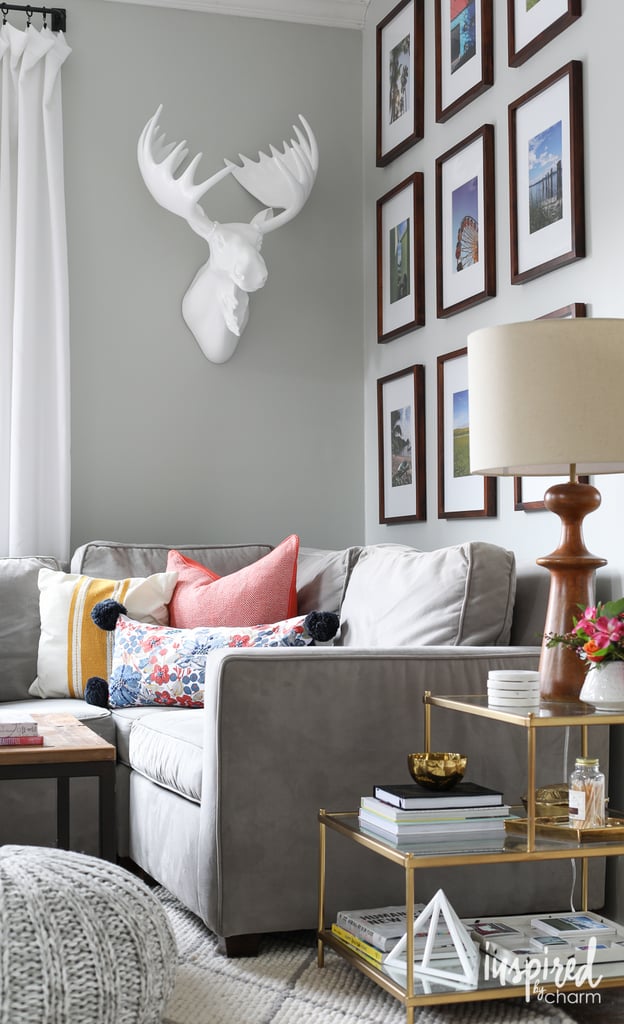
Image Source: Inspired by Charm
Once she’s assessed the flooring, Shelly is onto your wall colour and finishes. She advises that “using the proper paint finish for spaces is huge. Do not use a semi-gloss or a gloss paint finish on main living walls as it cheapens the space and looks too harsh. Stick with a flat or matte finish.” She also reminds us that nothing draws negative attention quicker than sloppy paint lines, so always ensure that those appear neat and finished.
Ceilings
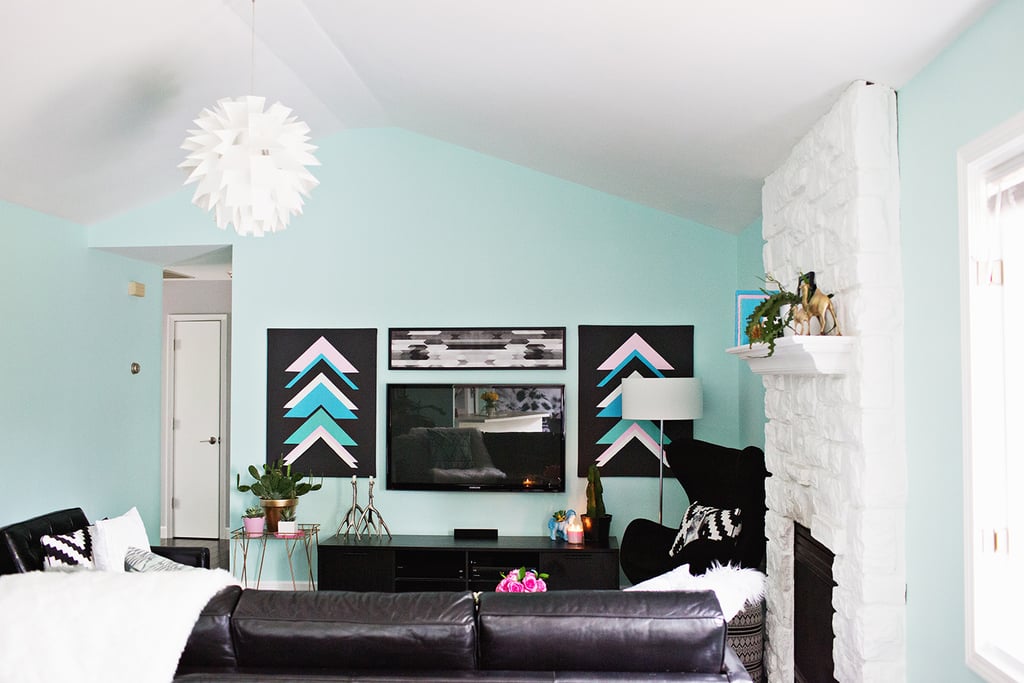 Image Source: A Beautiful Mess
Image Source: A Beautiful Mess
Another foundational element that will draw major attention from Shelly is your ceiling. Whether you want to modernise the appearance of your ceiling or you just need to open up the space a bit, this is one area that you won’t regret putting some time into. Shelly confirms that “smoothing out popcorn ceilings is a great way to add home value and to make spaces feel larger due to the shadows cast by this dated finish.”
Scale-Appropriate Furniture
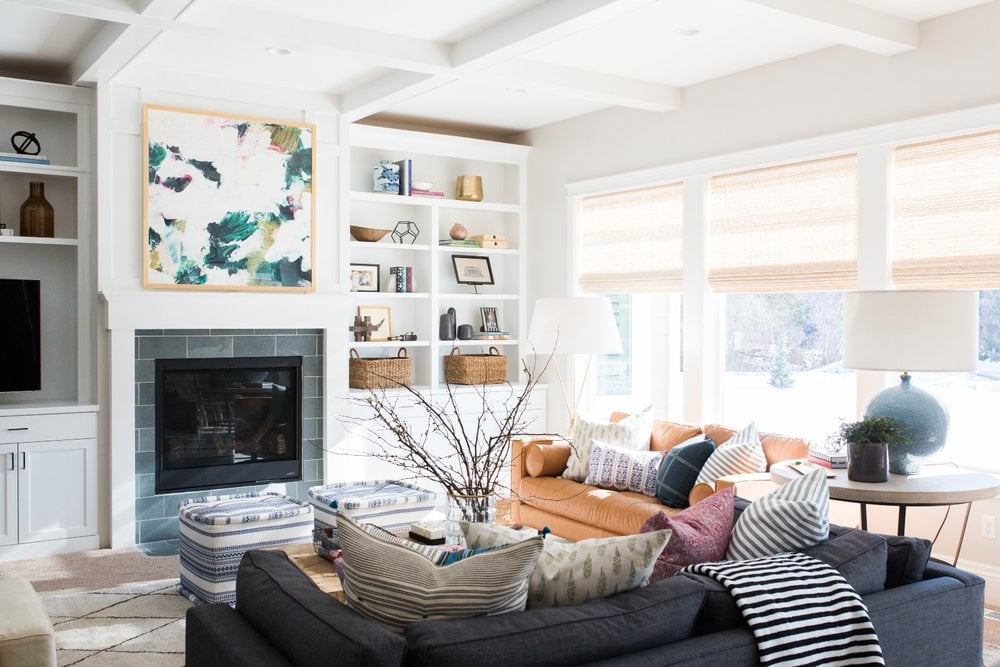 Image Source: Studio McGee
Image Source: Studio McGee
Properly scaled furnishings are key when it comes to creating a harmonious flow that’s sure to get noticed in your home. Shelly says, “Make sure that your furniture is not overwhelmingly large or so small that it looks out of balance in the space.” A huge sectional that is crammed into a space or a dainty nightstand displayed in an oversize master bedroom will do nothing but draw negative attention.
Clutter!
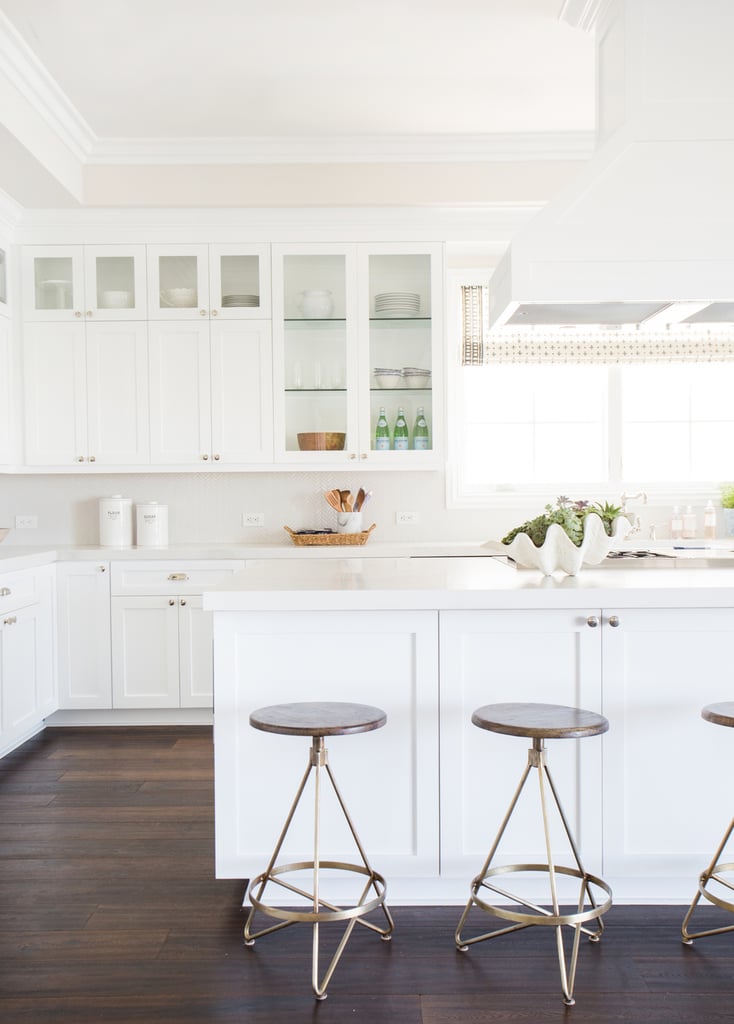 Image Source: Studio McGee
Image Source: Studio McGee
And lastly, we finish up with none other than that attention-grabbing eyesore: clutter. Yes, clutter! Shelly promises, “Keeping spaces clean and clutter to a minimum is a huge plus. Our spaces truly affect our well being, and spaces that are messy and dirty can have major psychological and physical impact.” Plus, not only will your guests appreciate your clutter-free home but you too will benefit from your Zen space.
Comments (0)
07 August 2018
By portermathewsblog
via https://www.therealestateconversation.com.au
Property prices in Perth have strengthened during the June 2018 quarter, according to fresh research from the Real Estate Institute of Western Australia (REIWA).

Simon McGrath, principal of Abel McGrath in Perth told WILLIAMS MEDIA now is the time to “be strategic and make a committment to securing a property in that location you’ve always wanted”, as data from the Real Estate Institute of Western Australia reveals property prices in Perth are strengthening.
REIWA President, Hayden Groves told WILLIAMS MEDIA the data indicates Perth’s median house price would settle at around $520,000 for the June 2018 quarter, which was up one per cent compared to the March 2018 quarter and two per cent compared to the June 2017 quarter.
“In addition, Perth’s median unit price is expected to lift by 4.9 per cent to $419,500 for the June 2018 quarter, which is 2.3 per cent higher than the same time last year,” Mr Groves said.
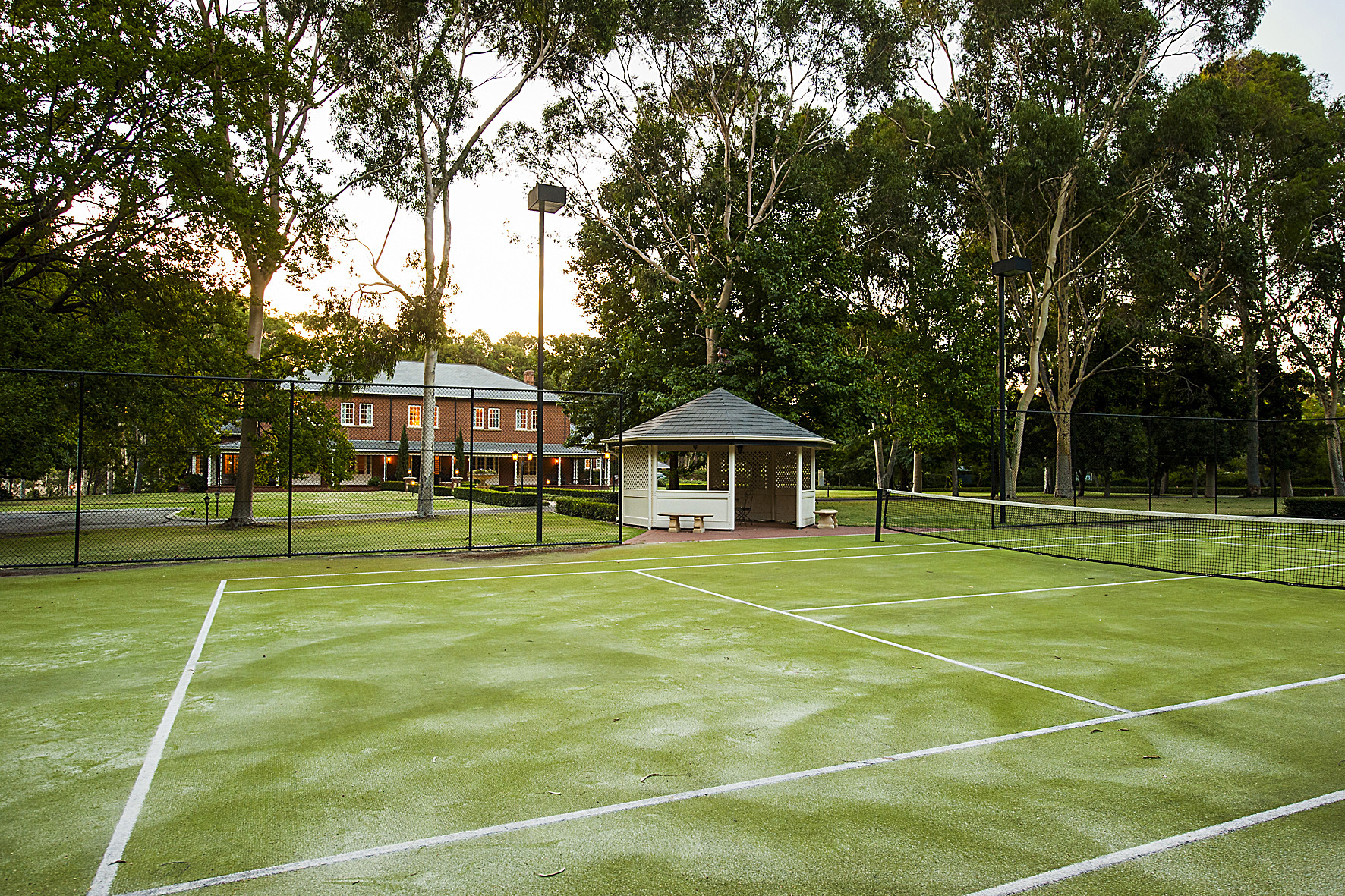 2045 Roland Road, in Western Australia is for sale through Neil McAllister of Bellcourt Property Group as featured on Luxury List
2045 Roland Road, in Western Australia is for sale through Neil McAllister of Bellcourt Property Group as featured on Luxury List
“After declining during the March quarter, it is pleasing to see prices rebound strongly this quarter. With the worst of the market downturn appearing over, the improvement in house and unit prices this quarter suggests buyer confidence is returning which should bode well for sellers as we move into spring,” Mr Groves said.
Mr McGrath’s advice to those looking to enter the market is to act now.
“At times like these, properties become available that would generally not be available. That is the big gift in this market,” McGrath said.
Overall, Mr McGrath says the market is “okay, but not great”.
“Perth is nothing but a big mining town. The flow-on effect from the mining industry affects Perth’s real estate market, so you’ve got a real upswing. Behind the scenes there is plenty of optimism.
“There is still plenty of caution in the market, prices aren’t shooting up. It is a very stoic market.
“We are seeing reasonable numbers at home opens, but it can be very spasmodic. Some home openings will be fantastic, others very quiet – there is no rhyme or reason to it,” Mr McGrath continued.
With 6,900 sales recorded during the June 2018 quarter, sales volumes declined during the June quarter. Mr Groves said the onset of winter likely contributed to subdued activity levels.
“It’s not uncommon for activity to drop off this time of year. Traditionally, activity tends to slow during the winter months before picking up again in spring,” Mr Groves said.
 2045 Roland Road, in Western Australia is for sale through Neil McAllister of Bellcourt Property Group as featured on Luxury List
2045 Roland Road, in Western Australia is for sale through Neil McAllister of Bellcourt Property Group as featured on Luxury List
Despite the overall decline in sales, numerous suburbs recorded more sales this quarter than they did in the last quarter.
“The suburbs with the biggest improvement in house sales were North Perth, Queens Park, Singleton, Camillo and Beldon, while West Perth, Balcatta, Rockingham, Claremont and Mount Lawley had the biggest improvement in unit sales,” Mr Groves said.
“Good quality family homes attracting a lot of attention”
REIWA data shows the composition of sales shifted during the June quarter, with more house sales recorded in the $800,000 and above price range than in the last quarter.
“The June 2018 quarter continued the trends observed during the December 2017 quarter, with good quality family homes attracting a lot of attention in aspirational areas,” Groves told WILLIAMS MEDIA.
“As the Western Australian economy begins to regain strength and owner-occupier loans remain the most affordable they have been in decades, buyers are recognising there is good opportunity to secure a family home in areas that might previously have been considered out of reach,” Mr Groves said.
Listing stock has “hit the ceiling”
Mr Groves told WILLIAMS MEDIA stock levels across the metro area have declined 1.1 per cent during the June 2018 quarter.
“We certainly appear to have hit the ceiling as far as listing stock is concerned. Despite fewer sales being recorded this quarter, it is encouraging to see stock levels have continued to be absorbed,” Mr Groves said.
On average, it took 67 days to sell a house in Perth during the quarter, one day faster than both the March 2018 and June 2017 quarters.
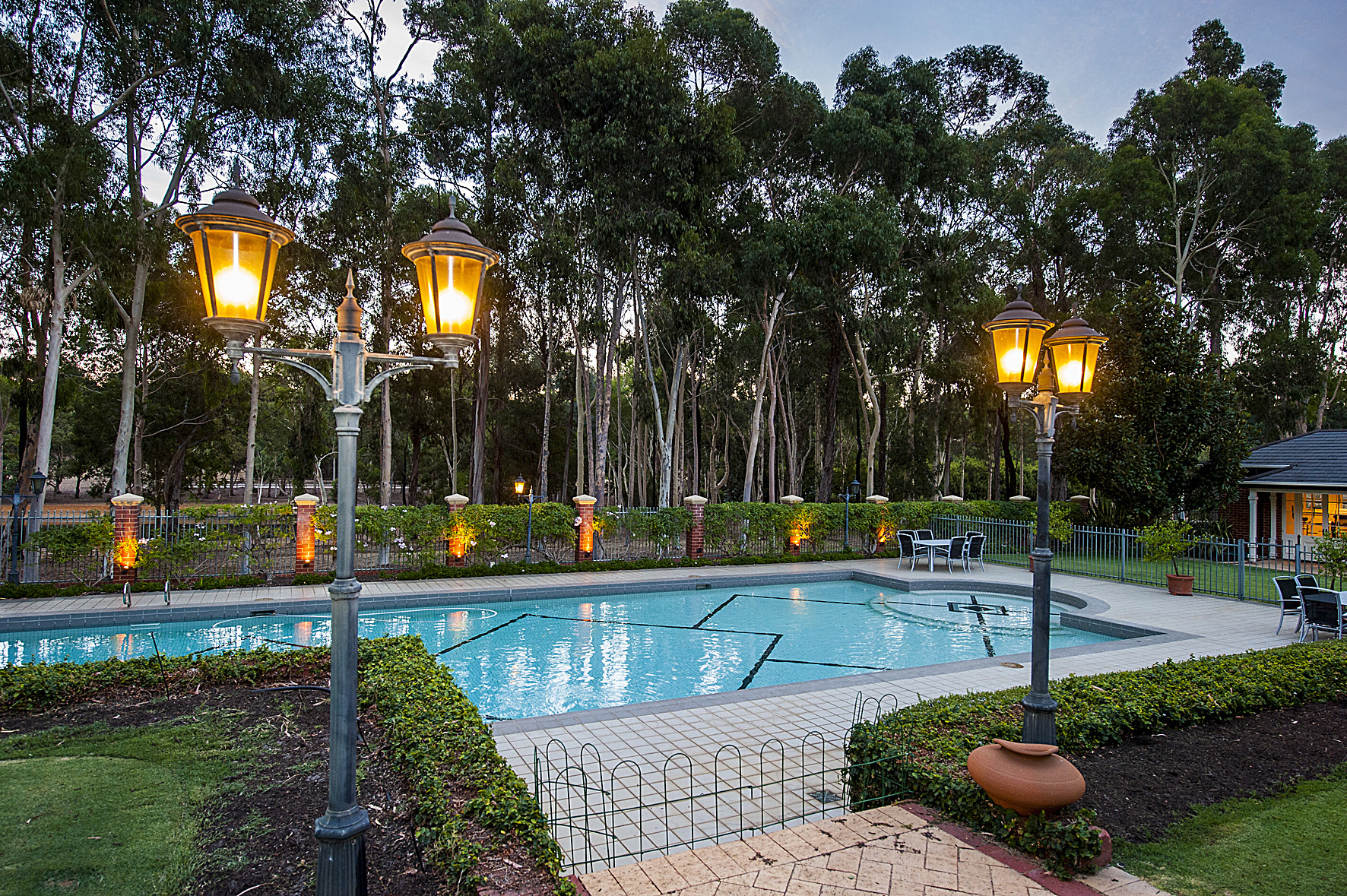 2045 Roland Road, in Western Australia is for sale through Neil McAllister of Bellcourt Property Group as featured on Luxury List
2045 Roland Road, in Western Australia is for sale through Neil McAllister of Bellcourt Property Group as featured on Luxury List
Mr McGrath told WILLIAMS MEDIA that although the market is pretty tough, his area in the western suburbs of Perth have short supply.
“There’s no denying – it is pretty tough. The good news in the western suburbs is that we have got short supply, whereas in the greater Perth market there is oversupply in many places. The short supply in the western suburbs is ticking the value of buoyance.” Mr McGrath said.
Less vendors discounting their asking price
Data for the June 2018 quarter shows the proportion of vendors who had to discount their asking price in order to achieve a sale declined by five per cent.
“With reductions observed in average selling days and discounting, this is a good indicator sellers are listening to the advice of their agents and pricing their property in line with market expectations,” Mr Groves said.
Comments (0)
23 July 2018
By portermathewsblog
via therealestateconversation.com.au
Real estate in Perth is at its most affordable on record, as falling prices give first home buyers their best chance of stepping onto the property ladder, according to the Housing Industry Association (HIA).
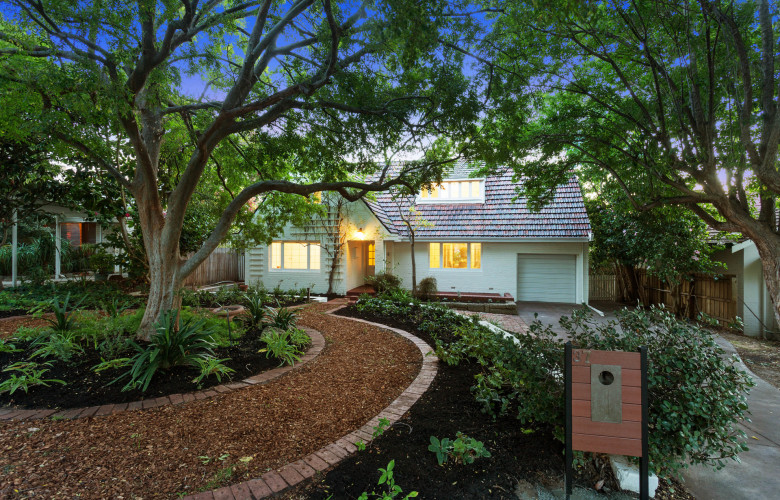 37 Marita Road, Nedlands, Perth under offer with Michelle Kerr from Abel McGrath as featured on Luxury List. Abel McGrath
37 Marita Road, Nedlands, Perth under offer with Michelle Kerr from Abel McGrath as featured on Luxury List. Abel McGrath
Figures from the Housing Industry of Australia (HIA) Affordability Index show Perth is the most affordable of the nation’s capital cities.
In the June 2018 quarter, the Housing Industry of Australia (HIA) Affordability Index registered 74.9, up by 0.4 per cent over the quarter and up by 0.8 per cent compared with a year earlier when affordability had reached its poorest level in nearly six years.
The HIA Affordability Index is designed so that a result of exactly 100 means that precisely 30 per cent of earnings are absorbed by mortgage repayments.
Higher results signify more favourable affordability – those above 100 signify that mortgage repayments account for less than 30 per cent of gross earnings, whereas scores below the 100 mark mean that more than 30 per cent of average earnings are absorbed by mortgage repayments.
According to HIA’s analysis, Perth is the most affordable capital city to buy a home in with an affordability rating of 111.7, closely followed by Darwin (95.6), Brisbane (93.4), and Hobart (94.4).
37 Marita Road, Nedlands, Perth under offer with Michelle Kerr from Abel McGrath as featured on Luxury List.
“Perth continues to present good opportunities for buyers, especially in the more affordable end of the market,” President of the Real Estate Institute of Western Australia (REIWA) Hayden Groves told WILLIAMS MEDIA.
In news that will surprise approximately no one, Sydney remains the least affordable capital city to purchase in, with a miserable affordability rating of 53.7.
Key findings from the HIA Affordability Report
- Easing price pressures are driving the improvements in housing affordability
- Housing affordability improved in five of Australia’s eight capital cities for the June 2018 quarter – Hobart, Melbourne and Adelaide were the only capital cities to see a deterioration
- Perth is now Australia’s most affordable capital city, followed closely by Darwin and Hobart
- Mortgage repayments account for 42.1 per cent of earnings in capital cities and 34.3 per cent in regional markets
HIA Economist Diwa Hopkins says affordability is hugely improving considering this time last year, affordability was at the lowest level in over six years.
“Easing house price pressures are providing some affordability relief for home buyers.
“Previous strong price increases were met by an unprecedented level of building which is now starting to come online. This is providing much-needed additional supply in key markets, helping to reduce price pressures and ultimately improve affordability for home buyers,” Hopkins said.
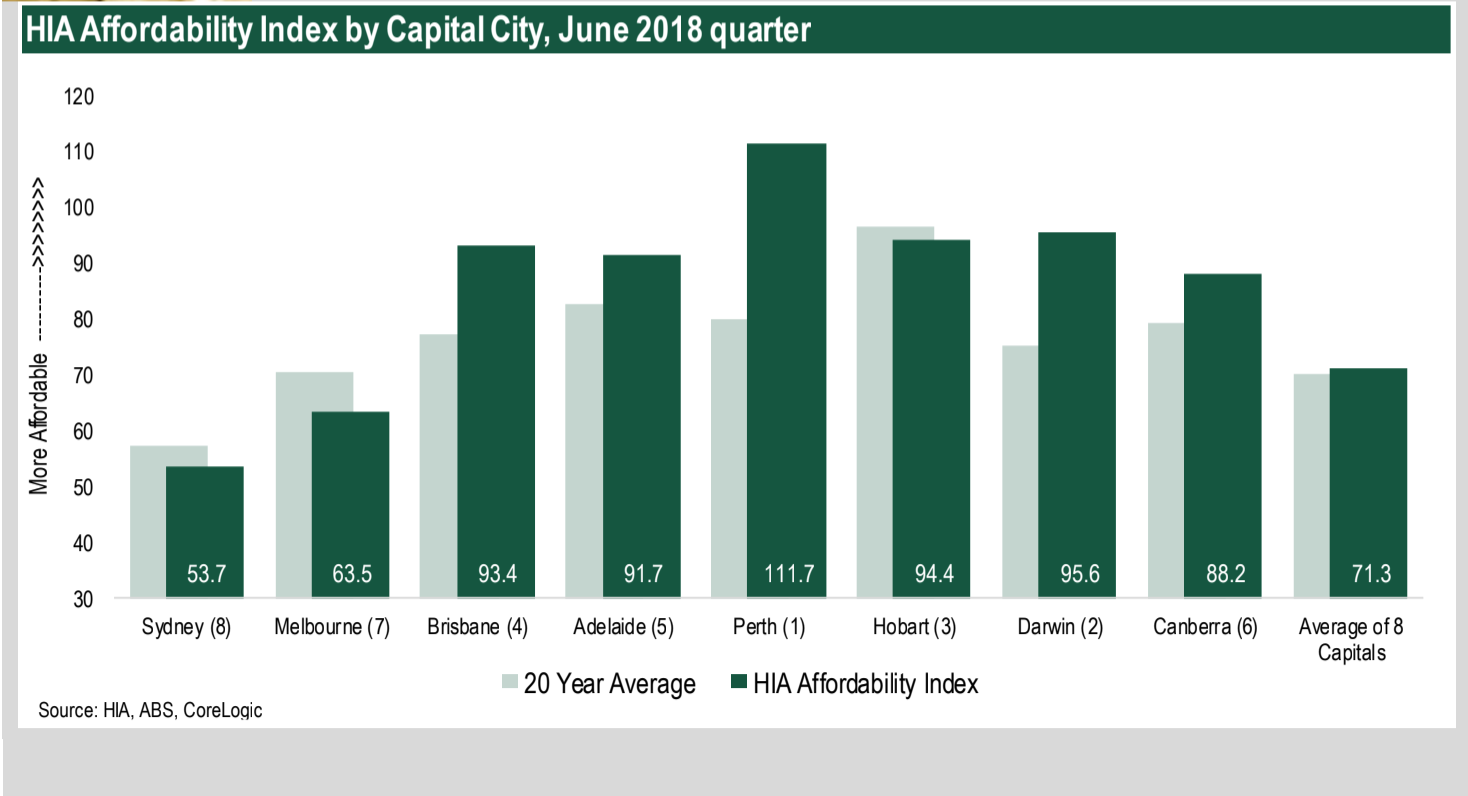 Source: HIA
Source: HIA
But the current plunge in house prices is unlikely to last for long, Hopkins warns.
“With an even balance in overall housing supply and demand in these key markets, the current downturn in dwelling prices is unlikely to be prolonged or severe.
“We could expect this downturn in prices to play out like previous cycles. They typically last 12 to 18 months, with the size of the fall modest relative to the immediately preceding expansion,” Hopkins said.
Ongoing fallout from the resources boom and bust cycles to thank for price plunge
Both rent and dwelling prices have been falling in Perth and Darwn for the last five years, amid the ongoing fallout from the resources boom and bust cycles.
While this is great news for renters and buyers in a market previously notorious for poor housing affordability, Hopkins warns it may be symptomatic of wider economic problems and in particular slowing population growth.
The weak economic conditions in both of these cities are seeing more people leave for interstate than are arriving, Hopkins says.
In particular population growth has followed these cycles and currently both cities are seeing more people leave for interstate than are arriving, resulting in spare capacity in their respective housing markets.
New home building activity has also fallen sharply in both cities as a result of the price declines, which risks causing an undersupply to emerge over the longer term in Perth and Darwin.
Groves told WILLIAMS MEDIA buyers are cautious right now.
“Trade-up family home buyers are lamenting they didn’t buy six months ago when the bottom of the market was apparent. Sellers who’ve been considering selling over the past few years are now cautious about coming to market too soon in anticipation of selling for more in the short-term future, especially down-sizers looking to maximise their capital-gains-tax-free benefit.
“Investors are likely to remain cautious until they see tangible growth which is likely to be towards the end of this year,” Groves said.
The best suburbs in Perth to invest in
According to data from REIWA, the rental yield for the Perth Metro region for houses currently sits at 3.6 per cent based on the overall median house rent price of $359 per week and median house price of $512,500.
This means on average, a typical property investor can expect to generate a 3.6 per cent annual return on their house purchase price.
REIWA says the suburbs of Bullsbrook, Medina, Parmelia, Armadale, Cooloongup, Maddington, Stratton, Camillo, Warnbro and Merriwa are house rental hotspots, offering investors the best return on their investment.
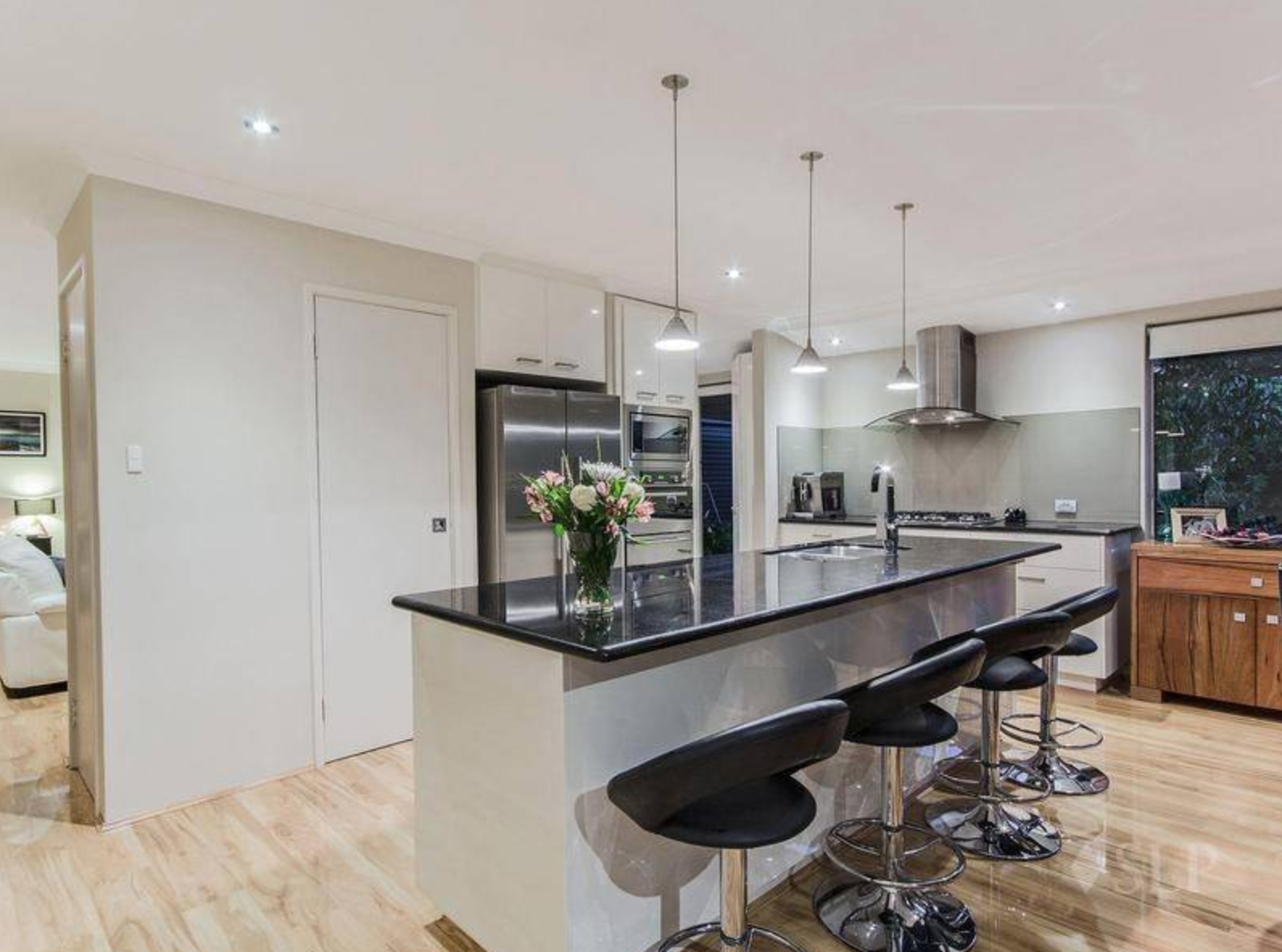 9 Bates Way, Warnbro available for rent through Property Osborne Park, as featured on Thehomepage.com.au
9 Bates Way, Warnbro available for rent through Property Osborne Park, as featured on Thehomepage.com.au
“Whilst the Perth property market is showing signs of a recovery in 2018, buyers and tenants remain the beneficiaries of the current environment, with a good supply of housing and rental stock to choose from at the more affordable end of the property market,” he said.
“With our local market on the cusp of recovering, now is the time for buyers and investors to take advantage of favourable conditions before our local market becomes less affordable,” Groves told WILLIAMS MEDIA.
Chief Operations Officer for Professionals Real Estate Group in Western Australia, Shane Kempton agrees.
“In the vast majority of areas in Perth, property prices are very low and buyers should now move quickly to secure a property before the recovery in the market gains further momentum to avoid buyers regret,” Kempton told WILLIAMS MEDIA.
View the Housing Industry of Australia (HIA) Affordability Index here.
Comments (0)
20 July 2018
By portermathewsblog
via houzz.com.au
Passionate about technology? A home-automation system is likely to be on your wish list – here’s what you need to know
In this practical series, we ask experts to answer your burning home and design questions. A premium home-automation system – also known as a smart-home system – allows you to control multiple functions in the home, such as lighting, heating and cooling, audio, security, door locks and even kitchen appliances – from a single device, be it a touch-screen remote control or an app on your phone or tablet, from wherever you are in the world.
Tempted? Here, Trevor Rooney, director of residential markets at Crestron, reveals everything you need to know about setting up a home-automation system in your own abode.

Home automation is all about convenience. Having the ability to control core elements in your home remotely, such as lighting, heating, entertainment and front-door access, can save time and make life run more smoothly.

Image: Crestron
What sort of things can a home-automation system do?
- Give you remote access to door locks so you can control who has access to your home when you’re not there.
- Switch lights on and off remotely or connect them to a timer or sensors, so they go on automatically (also great for security when you’re not home).
- Control heating or cooling so you can come home to a warm interior in winter or a cool one in summer.
- Give you remote access to alarms and surveillance systems; you will be notified if anyone approaches your home and can see who is at your front door. You can also switch surveillance on and off remotely.
- Change the television channel or switch the set on or off via voice command.
- Set your coffee machine to turn on automatically in the morning (it will even brew you a cup before you get out of bed).
- Automate your pool and pond cleaning, with the ability to adjust settings from your smart device while you’re not at home.

For even greater convenience, you can pre-determine the settings on your automated system for lighting, heating and entertainment to suit different situations. For example, you could set the system to control various elements simultaneously, so that when you go to bed it turns off all the inside lights, switches on the security camera at the front door, adjusts the kids’ night lights, and switches off the heater – all with one swipe of your smart-screen remote or an app on your phone.

Can automation cut my energy bills?
Absolutely. Here’s how:
- Accidentally left your lights on when you left the house? With home automation, you can switch lights off from wherever you are.
- Connecting blinds to a sensor-controlled system means they’ll close automatically when the temperature reaches a certain point, keeping your home cooler and reducing air-conditioning costs. You can also keep your home naturally cooler by setting up an automated shading system for overhead or exterior window shades.
- No more overheating your home unnecessarily; by installing a smart thermostat, your heating will switch off automatically when the temperature reaches a certain level.

How is a home-automation system different to a smart-home assistant?
Devices such as Google Home and Amazon Echo are great for convenience. They can perform simple tasks by using voice recognition, such as checking the weather, reading out the day’s headlines or performing Google searches.
A premium home-automation system is far more sophisticated. It allows you to automate several different devices through one simple-to-use interface or an app on your phone. So, instead of having five different remote controls to manage your various devices, you just have the one platform, which can be controlled by voice or touch.
 Image: Crestron
Image: Crestron
How does voice control work?
Systems such as those at Crestron can be connected to Amazon Echo’s Alexa Voice Service to enable voice control. This allows you to give voice commands, such as ‘Alexa, turn off the kitchen lights’ or ‘Alexa, raise the temperature in the family room by five degrees.’
You can also control multiple systems simultaneously through a number of preset scenes. For example, in the morning you could say ‘Alexa, tell Crestron to activate Morning Theme,’ and the blinds will slowly open, the lights will switch on and a warm shower will start running in the bathroom. Or, if you want to set the mood for an intimate dinner party, simply say, ‘Alexa, tell Crestron to activate Intimate Dinner.’ The dining room lights will dim, the window coverings will adjust and soothing music will play from your speakers.

What should I expect to pay?
This depends on the level of automation you want. Crestron’s new PYNG 2.0 platform (available later this year), which controls audio/visual functions, such as the television, Foxtel, Apple TV and Sonos, starts from around $3,500. This would include the processor and a touch-screen remote control. Incorporating lighting and shading solutions into a home-automation system would see this cost rise to around $10,000, depending on the size of the space.
A fully connected smart-home system starts from around $25,000, depending on the size of the property.

Can I retrofit an automated system?
It’s best incorporated during the building phase. However, it’s certainly possible to install after the build.

Comments (0)
16 July 2018
By portermathewsblog
via therealestateconversation.com.au
Be a smart investor and have a loan strategy.
You have saved away and have enough cash to consider purchasing property as an investment. Like any purchase, it is a huge one so having a strategy in place will keep you focused and ensure that you are doing as much due diligence as you can for a successful investment.

Not many successful investors became successful by accident – we recommend you start by seeking professional financial advice to really determine what your borrowing capacity is and how realistic your investment is.
Debt does not have to be scary, unless it is the wrong type of debt. In an ideal situation, you will want your debt to be productive and if you have planned how your cash flow will be affected, then you can have a clear understanding of how purchasing that next investment will affect your lifestyle. Productive debt in our eyes can be used as an advantage to buy an asset or generate income such as rental income.
Understanding your loan strategy
If you are looking to invest in multiple properties, we think it’s important to understand the short and long term perspective of property ownership. You have to think about how this next loan or investment is going to influence your life and your cash flow as well as what the situation might look like with your third or fourth investment. We say this as it can really make a difference in the type of property you purchase in the first place.
Think about how positively or negatively geared loans will affect what you purchase or how you live in the future. It may seem odd to be thinking so far in advance, but we think it is important to really understand your financial situation and also the results you would like to achieve as a property investor.
This is where we think it is important to be surround by the right advice. The right financial advisor for you will be able to help you plan the various scenarios to suit your end goal – after all everyone has different goals in their lives.
Comments (0)
09 July 2018
By portermathewsblog
via reiwa.com.au
 Are you looking to jazz up your home but don’t have the available funds? Maybe you are planning to sell, or just want to give it a facelift?
Are you looking to jazz up your home but don’t have the available funds? Maybe you are planning to sell, or just want to give it a facelift?
Either way you don’t need to spend an arm or a leg, you just need a little bit of inspiration.
Here are five ways you can give your home the ultimate make-over without breaking the bank.
1. Clean out/de-clutter your home
Start by a good old clean out – this you can do for free. Living in a messy, cluttered house will have you feeling anxious and itching for a change of atmosphere, plus it won’t make a good first impression on visitors.
rid of junk you don’t need, wash the walls, doorways and clean all the dust and cob-webs! This will have an immediate effect on the oxygen circulation of the house – breathing in fresh air is the start to feeling good in your home.
2. Paint the walls
Whether you want to change the colour all together or just want to lift the look,the most effective way to rejuvenate your home is to apply a fresh coat of paint.
Light to neutral colours gives you more flexibility with furniture and décor, and creates the illusion of space. Plus, painting your home is relatively cheap, unless you want to seek a professional painter to do the job.
While you have the paint out, it is also a good idea to re-paint the doors, door frames, skirtings and ceilings in simple white, to freshen up the aesthetic of your house.
For some inspo, find out how to select the right paint colour for your home.
3. Re-decorate
It is ridiculously affordable to decorate your home these days, you just need to trigger your creative side.
Adding plants and some pottery to your home is a great way to set the mood and can be very affordable and easily maintained with a little bit of TLC. Adding a splash of greenery to your space is not only aesthetically appealing, but pot plants also help purify the air, just make sure you buy plants suitable for indoors.
Candles, incense and infusers also have dual purpose when it comes to décor. They look good, and smell good, once again adding that infused delicious aroma to your home.
When it comes to the bedroom and living rooms, pillows, throws and new linen is something that will always catch the eye. What better feeling is there than purchasing fresh new bedding? Try and coordinate this with whatever colour you paint the walls or keep the same colours but you can mix up the styles.
Remember, simple can sometimes mean more, so try keep all decorations minimal but effective.
4. Rearrange furniture
If you already love your furniture but still feel sick of it, a simple re-organise of the couches, TVs beds, tables etc can make you feel like you’re in a whole new house.
Making different uses out of the things you already have in your home will save you money. You think you might be sick of an item, but put it somewhere else and you might fall in love with it all over again.
5. Update light fittings
Lighting is the key to making any home stand out, and you would be surprised what a simple swap of the light fittings will do.
If you’re on a budget consider going for one or two designer light fittings in the main living areas, then cheaper ones for the other rooms.
While we are on the topic of lighting, you can also replace the light switch covers which won’t cost you a lot at all. Swap out those old fashioned, plain switch covers for silver, stainless steel or modern white covers.
Comments (0)
02 July 2018
By portermathewsblog
via houzz.com.au
An interior designer reveals the essential rules for achieving a perfectly balanced interior.
Have you ever walked into a room and it just felt right, but you couldn’t put your finger on exactly why? Chances are that proportion was a key factor – whoever designed the room would have paid careful attention to getting the size and scale of the furniture and accessories just right for the space.
We talked to Rohan Smith, senior interior designer at Coco Republic Interior Design, to find out how you can create beautifully proportioned rooms in your own home.
 Why does proportion matter?
Why does proportion matter?
Because furnishing a room is more involved than simply placing a few pieces of furniture in a space – some fundamental rules of design need to be considered, one of the most important being proportion. You need to consider not only the proportional relationship between the pieces themselves, but to the space that contains them.
A room looks and feels right when the proportions are good, and there’s neither too little nor too much furniture. If furniture is too big, the flow of the room can feel awkward. If it’s too small, the space won’t feel cosy or inviting.

What are the most common mistakes people make?
Having all the furniture and furnishings in a room the same height, colour and style. The room ends up looking dull and static. This is easily rectified. A tall floor lamp, for example, can add some height to a corner, while providing a lovely ambient light source. A tall cabinet or bookcase can add visual interest as well as handy storage.

How do you assess proportion?
One of the easiest ways to assess whether a sofa, dining table or bed will suit the size of your room is to map it out with newspaper and lay it on the floor. This will give you a sense of how much floor space the piece will take up. Living with this template for a few days will give you a definite feel for how it will be to live with the piece.
A more technical method would be to use the Houzz Sketch tool or an app such as Magicplan. You simply take photos on your smartphone, which the app then translates into a plan of the space. You can then add objects, annotations and attributes to create a complete plan of your room.

What proportions do you need to consider for a living room?
Living rooms can be tricky to get right, especially in open-plan spaces.
If the room is your main television viewing space, then you’ll need to factor in technology as well as furniture. Is the TV too big for the room? Is the entertainment unit balanced with the size of the TV, and the room as a whole? A common mistake is to have a small entertainment unit with a large TV – it should be the other way around. Also, consider whether the sofa is the correct distance from the TV for viewing comfort. It should be about 2.5 times the screen width in distance away, and no more than 5 metres. The centre of the TV should be about 1 to 1.1 metres from the floor.
A large sofa and a small rug also look unbalanced.
For living rooms, the furniture arrangement should be conducive to conversation. Two sofas facing each other or a U-shaped arrangement are ideal. The coffee table should also be the right height for the sofa. You should be easily able reach the coffee table from a seated position so you can rest a cup of tea or a glass of wine.

What about a bedroom?
One of the main considerations in the bedroom is the size of the bedside table in proportion to the bed. For a king-size bed, go for a large-scale beside table of about 70-90 centimetres in width, depending on the size of your bedroom. For a queen-size bed, a bedside table of around 50-60 centimetres is ideal.
Bedside lamps should also sit proportionally with the bedside table and bedhead. Again, for a king-size bed, a larger lamp will work best.

Are there any golden rules for hanging pendant lamps?
When pendant lamps are hung too high or low, they can look completely out of place in a room. You need to consider the size and style of the pendant, the ceiling height, and the space in which they will be hung.
Despite these variables, there are still a few hard-and-fast rules that can help when hanging pendants. For kitchen benches, hang lights around 70-80 centimetres above benchtops. This height allows the pendants to provide a useful light source for working, without intruding on the line of sight from the kitchen to the adjoining living or dining room.
For your dining table, sit pendants at 75 centimetres above table height to create an intimate and cosy dining space. For entries and hallways where people will be walking beneath the pendant lights, space allowing, the ideal hanging height is 240 centimetres from floor level.

What about hanging art?
Choosing artwork that is the wrong scale for a room is a common mistake, with most people erring on the small size. Checking to see whether a gallery will allow you to bring a piece home on approval is the best way around this. If you fall in a love with a piece that is too small for your room, have it re-framed with a larger mount.
Another common mistake is to hang artwork too high on the wall. If a piece is hung too high it will have no connection to the furniture below it, and if it’s above eye level it can ruin the look of a room.
Ideally, artwork should be hung so that the centre of the piece is at average eye level or about 150 centimetres from the ground. In a dining room you might want to hang the pieces slightly lower to factor in the seated viewing height.
Also remember that having some negative space is important. Leaving some walls bare not only puts more significance on the pieces you’ve hung, but creates a calmer feel in the room.

And rugs?
Rugs are a great way to bring a furniture grouping together. They provide a border for furniture to sit on and can help you create individual dining and living zones in an open-plan room where furniture has a tendency to ‘float’. Ideally rugs should sit under the front legs of the sofa and occasional chairs – this helps visually link the pieces together.

What about the proportions for colour in a room?
When making your selection, consider the 60-30-10 rule, which is a timeless decorating principle that can help you create a balanced colour scheme. Your 60 per cent is the main colour for a room, which anchors a space and provides a backdrop for the other colours. In a living room this would be walls, sofas and rugs.
Your 30 per cent is the secondary colour, which would encompass occasional chairs, bedlinen, window furnishings and occasional furniture. It should support the main colour, while being different enough to set it apart and give the room interest.
The final 10 per cent is your accent colour. For a living room, this would include scatter cushions, decorative accessories and artwork. For a bedroom, think throw pillows and artwork.

Do the rules of proportion apply to the little details too?
Keeping an eye on the proportion of decorative accessories is another important consideration. One large bowl on a dining table might be all you need in that space to create drama. Conversely, combining small objects with other similar objects can create just as much impact. A collection of ceramic pots makes one big statement, whereas a few pots scattered about will look disconnected and out of proportion.
Lamps should not overshadow the table on which they are placed. A large lamp on a slender table, for example, would appear top heavy. Too much variety of scale can cause visual chaos in a focused area, such as a bookshelf. Instead, group items of similar type and scale together, and line up like-sized books for a balanced look.

Comments (0)
22 June 2018
By portermathewsblog
via popsugar.com.au
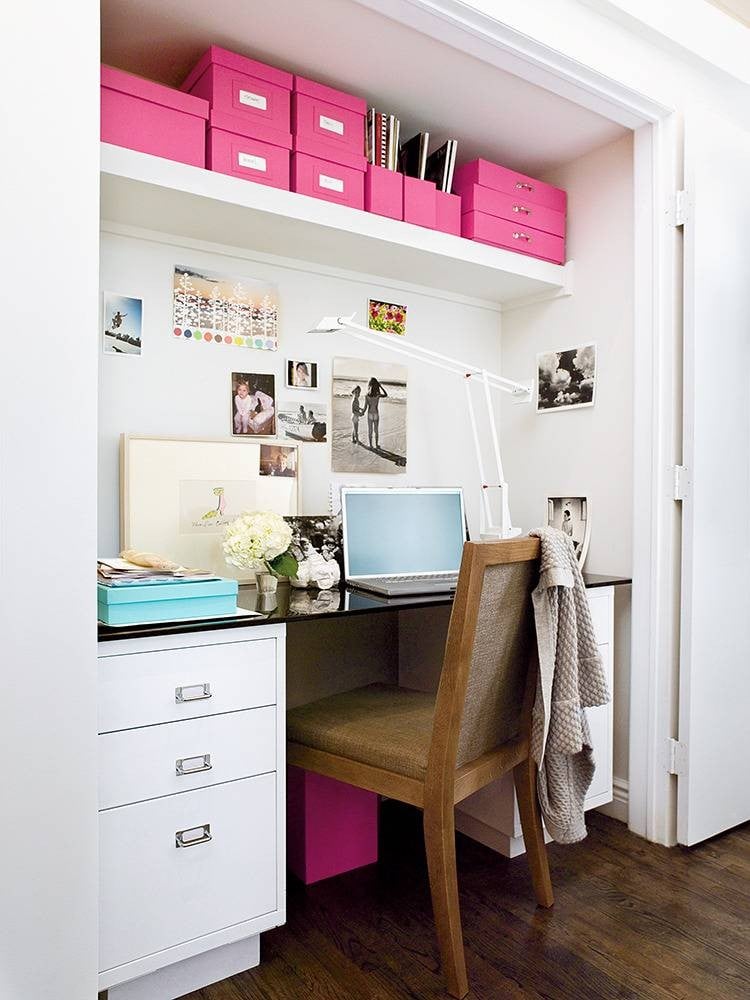
If searching for your keys is a part of your morning ritual, it’s time to break the cycle. Being organised is more than just a personality trait, it’s a lifestyle decision that’s easier to achieve if you stock your home with the right tools. These 15 clutter-busting essentials will make your days feel longer and less stressful. Cheers to that!
Idea: If you don’t want to hang a key hook, do yourself a favour and get a key catchall. Having a designated place to place your keys when you walk through the door will save you from the “running late” syndrome. Don’t be that person.
Get it: Making your own leather catchall is easier than you’d think. Follow this tutorial on A Beautiful Mess to DIY your own
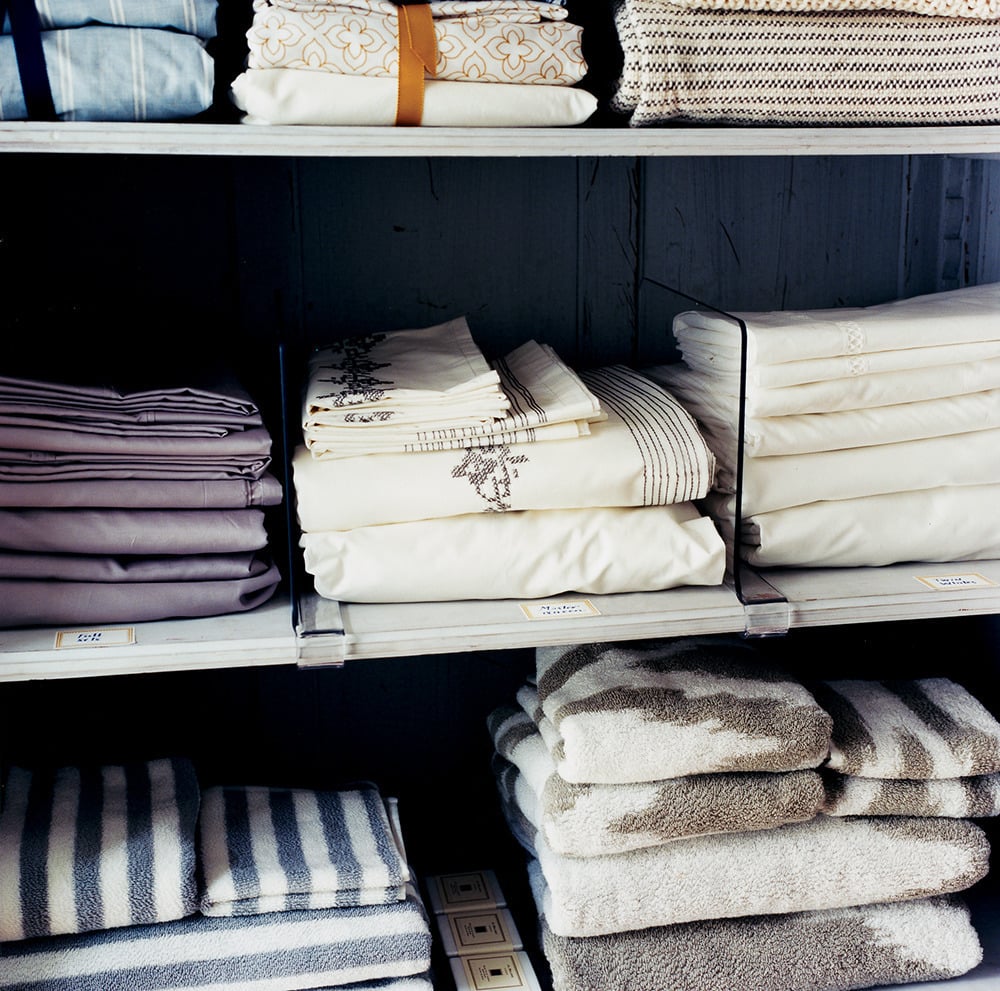 Image Source: Bahar Yurukoglu for Domino
Image Source: Bahar Yurukoglu for Domino
Idea: You know how it goes . . . You take the time to meticulously fold sheets and towels, and by the end of week, it looks like a bomb exploded in your linen closet. Here’s where clear shelf dividers come in. They’ll keep your stacks of linens in order without creating an eyesore.
Get it: Stock up on these acrylic shelf dividers to tame your most unruly closet.
Idea: Put your pantry on display by keeping dried goods and other treats in lidded glass jars.
Get it: You can get her kitchen jars at Ikea.
Idea: If you’ve seen these used to hang pots and pans, you’ll be happy to know that the idea translates for any room in the house. We love how Sugar + Cloth blogger Ashley Rose used one for above-the-bed storage and decor.
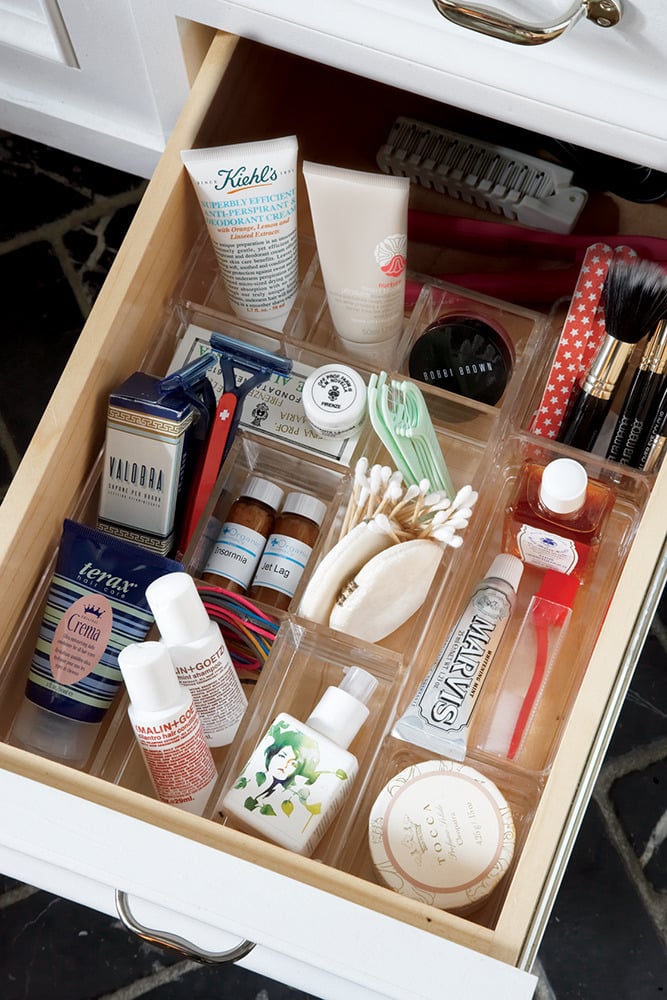 Image Source: Paul Costello for Domino
Image Source: Paul Costello for Domino
Idea: If shuffling through a drawer to find a tube of lipstick gives you anxiety, you’ll be amazed by the efficiency that a simple drawer organiser can offer.
Idea: Forget the space-saving allure of forgoing a knife block — we’re crazy about the fact that you can see the shapes and sizes of your most utilised knives while keeping them in reach.
Idea: It’s amazing how quickly a tray can corral clutter. Bonus points for turning the top of your toilet into an extension of your medicine cabinet (with the addition of a slim bud vase and framed picture, of course).
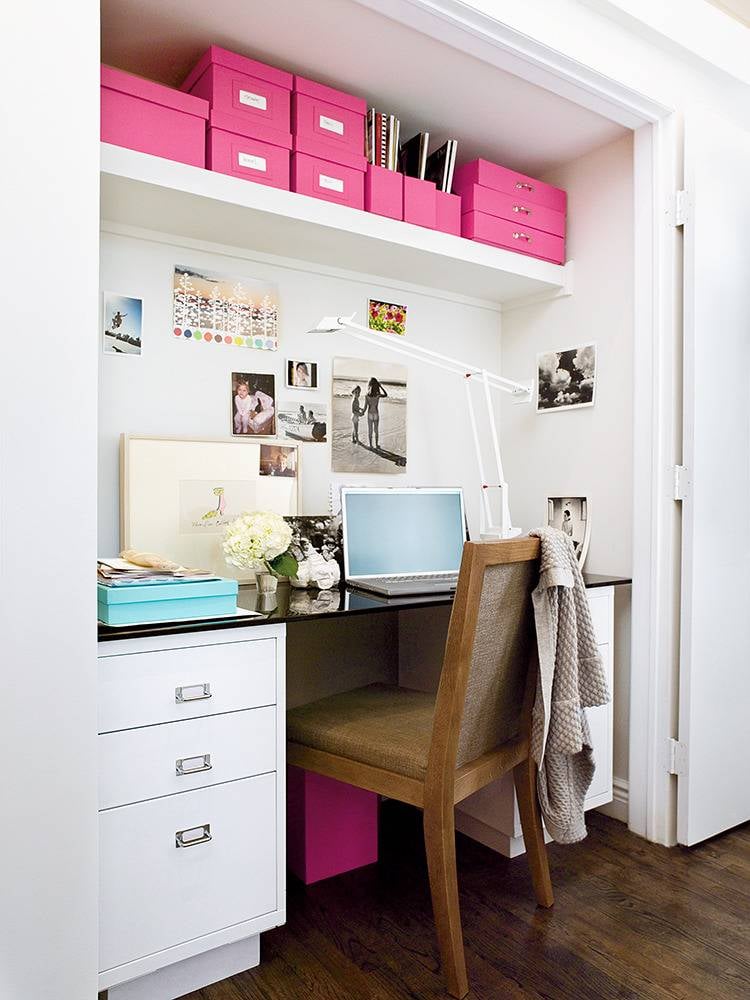 Image Source: Cahan Eric For Domino
Image Source: Cahan Eric For Domino
Idea: Labelled boxes are a great way to organise the things you want out of sight.
Idea: Sure, you can use them to hang a curtain, but they work wonders in making the most out of shelves. Follow Martha Stewart’s lead, and use them to organise kitchen items like pot and pan lids, trays, and cutting boards.
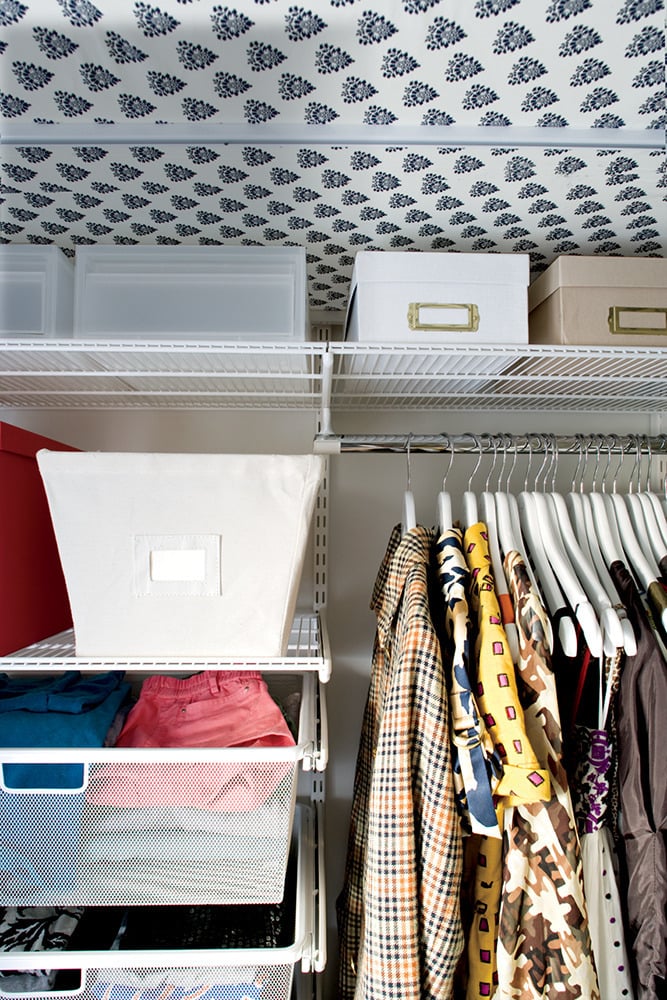 Image Source: Lesley A. Unruh for Domino
Image Source: Lesley A. Unruh for Domino
Idea: Whether you need more storage space for clothes or craft supplies, these wall-mounted mesh drawers allow you to customize your storage and easily see what you’re storing.
-
Makeup Brush Cups
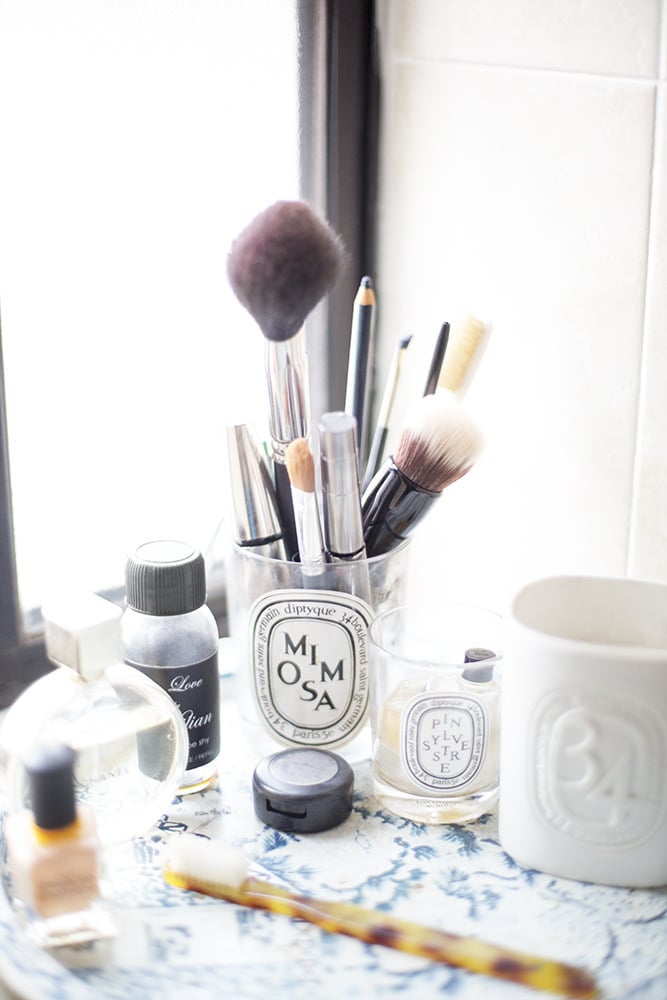
Idea: Instead of cramming makeup brushes into a messy drawer or makeup bag, keep them within easy reach in a stylish cup.
Idea: Whether it’s a drawer filled with neat rows of spices or a creative DIY that frees cabinet space, every organized cook seems to have their spice collection under control.
Get it: A Beautiful Mess has an easy-to-follow tutorial for making these nifty magnetic spice jars.
-
Clever Toilet Paper Storage
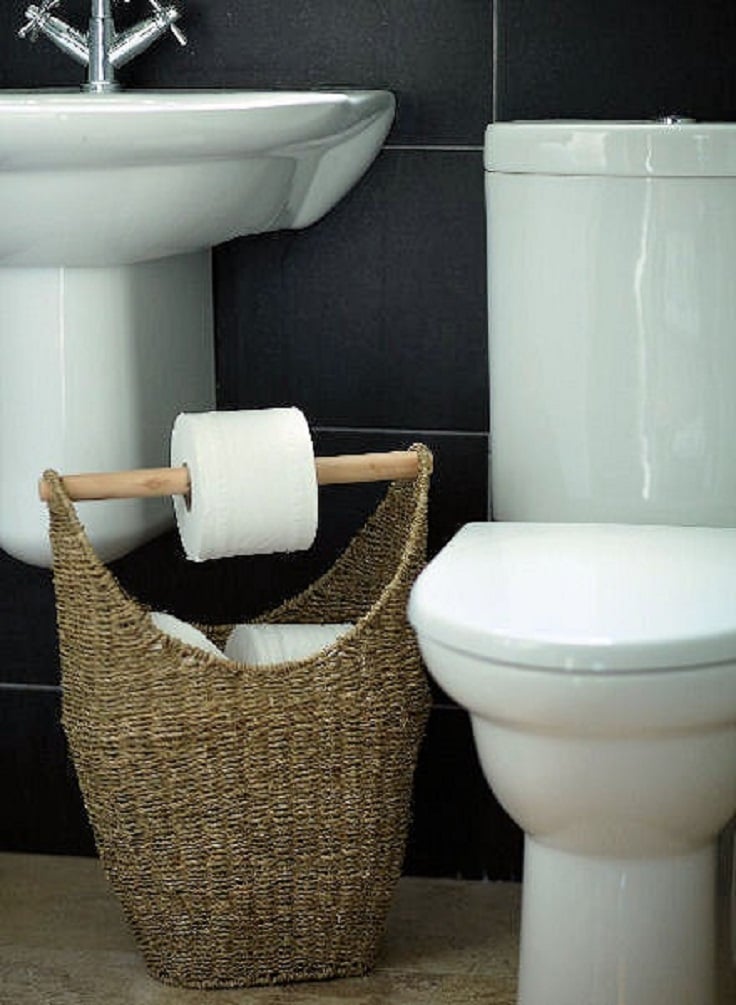
Idea: Running out of it when you need it is the worst, but stacking it in plain sight can cramp your bathroom’s style. Kill two birds with one stone by turning a basket into a toilet paper organiser and dispenser.
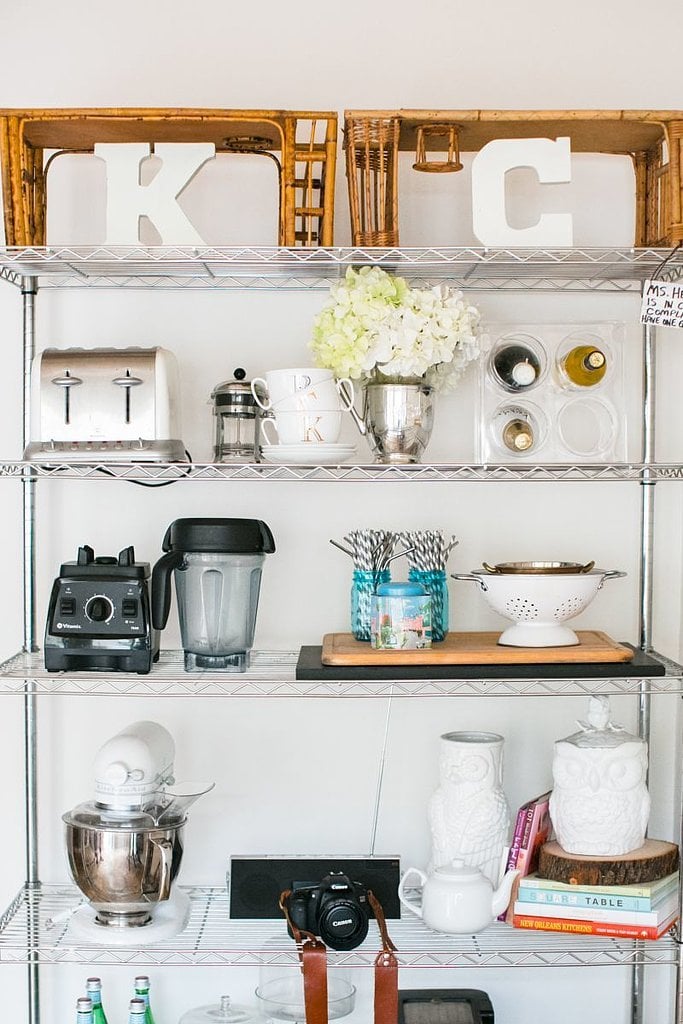 Image Source: Monica Wang for The Everygirl
Image Source: Monica Wang for The Everygirl
Idea: A lack of cabinet space doesn’t have to stop you from owning bulky appliances like KitchenAid mixers and high-powered blenders. Some of the cutest rentals we’ve seen use stainless steel shelves for stylishly organization, making it easy to keep everything within sight. The best part? You can extend them or shorten them for a customized height.
Get it: This shelving unit is a great starter package.
Comments (0)
18 June 2018
By portermathewsblog
via therealestateconversation.com.au
Buying and selling property in WA has traditionally been by way of a conventional private treaty arrangement, however buyers and sellers are missing out on a more pure form of transaction, and that’s the auction.

Granted, auctions are becoming a more accepted selling method and the numbers of weekly auctions in WA has increased significantly over the past five years, but still lag a long way behind private treaty sales and the Eastern states. So why is that we’ve been slow to jump on the auction bandwagon?
Firstly, WA’s law for property transactions using the current “Offer & Acceptance” method protect both buyer and seller and in the majority of cases are easy to follow. The system works effectively for all parties to the transaction including the buyer, seller, settlement agent/conveyancer and banks. The downside of this system is that is can be time consuming and in many cases is conditional upon buyers obtaining finance, property inspections, having to sell their current home, etc.
More importantly, the system has a major flaw in it and that’s the asking price is disclosed and typically buyers knock the price down to where they feel comfortable – so it’s not good for sellers.
So why should we look to auctions? The auction system is the most pure form of selling and buying as there are no “secrets” surrounding price or selling terms; all terms are provided in the marketing campaign and the buyers set the price on where they see value. Selling by auction in most cases is quicker than private treaty. And the seller has three bites of the cherry; sell before auction day, on auction day or usually within 30 post auction day.
There are two main misconceptions surrounding auctions:
1. They cost too much. The cost of the auction is merely the auctioneer’s fee for calling the auction and working with the seller, buyer and agent to achieve the desired result. Typically, an auctioneers’ fee is in the vicinity of $700 to $1000. All other costs are associated with the marketing campaign to promote the property.
2. Auctions only “work in expensive areas”. That’s just a suburban myth. There’s many examples of properties below the current Perth median price of $510,000 selling at auction.
WA is one of only two states, the other being Tasmania, that don’t have a cooling off period in our property contracts. A cooling off period allows the buyer to “break” the Offer to Purchase usually between 2 to 5 business days after the offer has been signed. In other words, if the buyer changes their mind for whatever reason they can legally break the offer and walk away for a very small consideration to the seller, usually between 0.2% – 0.25% of the purchase price.
As WA doesn’t have cooling off provisions in our property contracts, this makes it far too easy for sellers and agents to default to Private Treaty transactions. If cooling off provisions were introduced to our property contracts, I’d predict a huge increase in the number of property auctions taking place in WA.
Finally, too few real estate agents embrace auctions and the auction process with vigor. They lack confidence and in some cases, the ability to explain the different marketing options available to sellers and automatically default to Private Treaty. This is a marketing injustice to sellers and the sooner we can demystify and legitimise the auction process for both buyers and sellers, the better.
Comments (0)
11 June 2018
By portermathewsblog
via therealestateconversation.com.au

Buying your first property is hard, so let’s make it easier for you.
Congratulations! You have decided to take the plunge, you have done some reading on what the various responsibilities when it comes to being a homeowner, you have spoken to the bank and have an idea of how much you are able to afford.
These steps take some time so we are here to encourage you to take the next step in home ownership. We know it’s a little bit nerve wrecking and a little bit scary, but we have compiled some advice from our in house experts to help you with this exciting time!
Looking for affordability without compromising on location
For many of us, your first home is not going to be your forever home. We recommend taking a holistic approach to purchasing property. Even if you are going to be living in that property, look at it as an investment as well.
For those first homebuyers who do not want to compromise on space, you may have to look further out depending on your budget or look for townhouses or terraces. If you are looking to keep more of your lifestyle, an inner city apartment may be the apt living situation for you.
What we emphasise is buying smart and seeing your home purchase as more than just a living situation but a step in growing your portfolio. You might want to ask yourself “How much rent will I get for this apartment?” or “What has been the capital growth in the area over the last few years?”.
We think asking these questions will not only give you peace of mind if you have to move out and rent or sell your property, but it is also how many people start their property portfolio. The first one does not have to be picture perfect, but it helps if it is a sound investment.
Location and amenities
The building, home or internal features are not the only things that you should consider when you buy. Are you in a desirable school catchment zone, are there amenities or transport facilities planned in your area or has a new shopping centre been planned?
Looking at the amenities and area around you is particularly important, as they are great financial health indicators that the area you are looking to buy in has infrastructure and amenity to attract people to live there.
Look on suburb out from your dream location
Looking for undervalued suburbs next to the pricier areas is always a something we recommend to our first home buyers – over time, population growth and gentrification will mean that there will be capital growth in your area.
It’s always good to also look at areas with employment growth as this will increase demand for homes in that area. Finally, do your research. It takes time to go through all the listings in the area you love and view the various prices they get sold for but it’s all worth it when you know you are on to a great purchase.
Comments (0)
01 June 2018
By portermathewsblog
popsugar.com.au
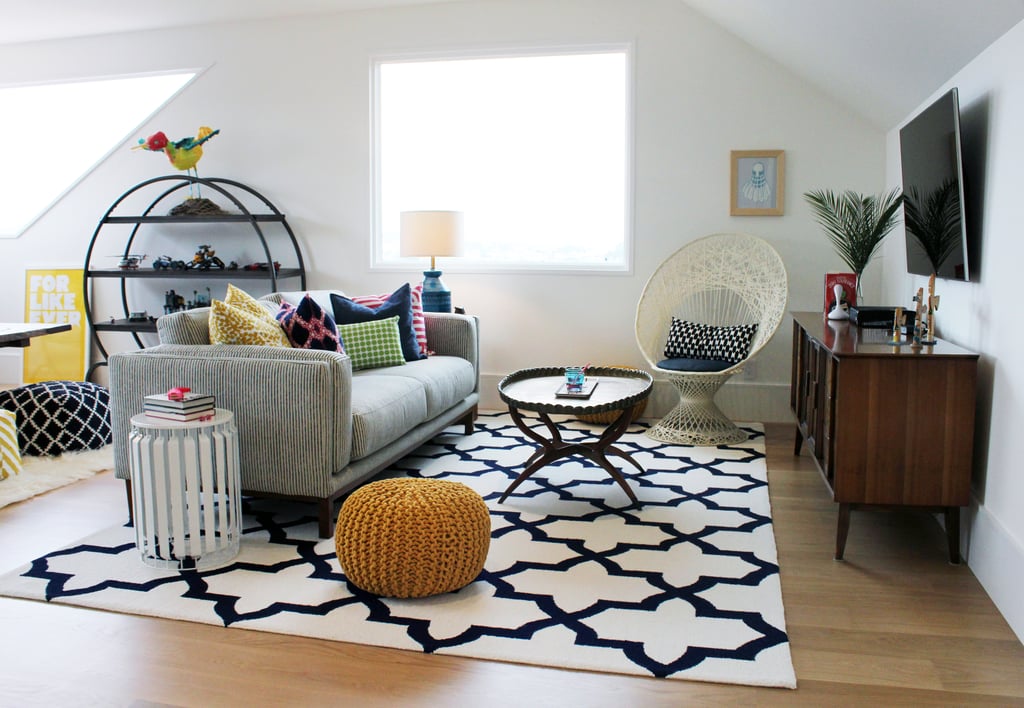 Image Source: POPSUGAR Photography / Lisette Mejia
Image Source: POPSUGAR Photography / Lisette Mejia
If the idea of getting your home company-ready is keeping you from hosting a dinner party or even your out-of-town in-laws, we can help. Sure, you could spend all day cleaning and decorating in anticipation, but who has the time? Here are the only things you really need to do before your guests arrive. Don’t worry — they are nothing but easy.
The Scent of Your Home
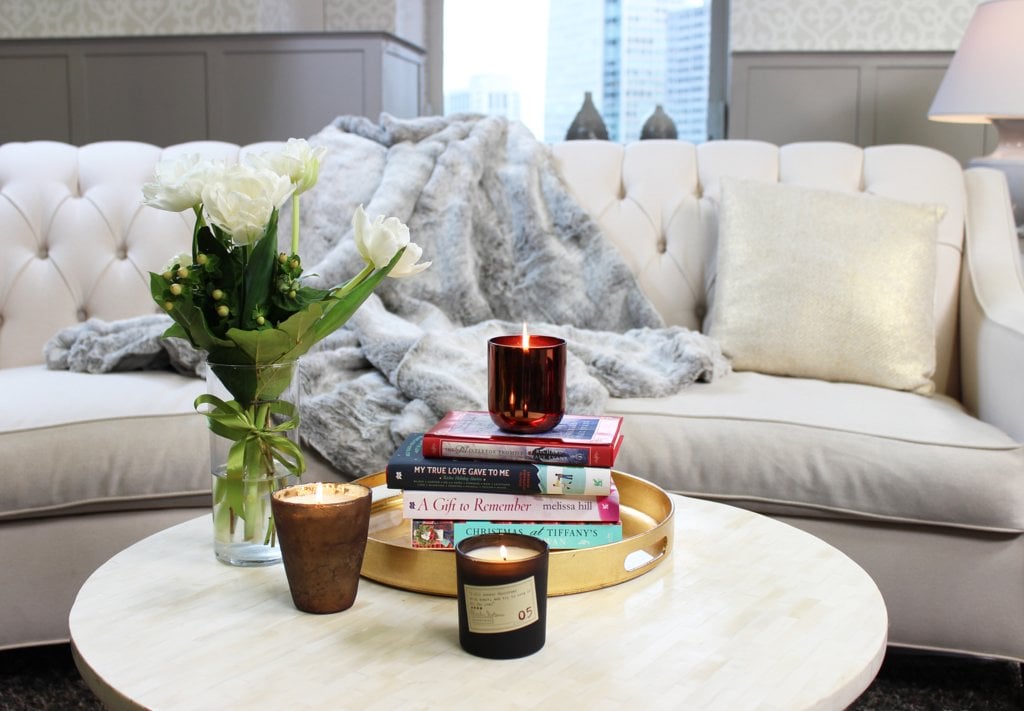 Image Source: POPSUGAR Photography / Brinton Parker
Image Source: POPSUGAR Photography / Brinton Parker
Decor isn’t the first thing guests
notice when they walk through your door — it’s the smell. Whether you’re
concerned about the fish you cooked the night before or your dog skipping a
bath — or worse, the scents you’ve become nose-blind to — put your
mind at ease by lighting a candle or simmering a small pot of citrus peels and
cinnamon sticks a half hour before guests arrive. We can’t get enough of these yummy-smelling candles.
A Well-Stocked Bar
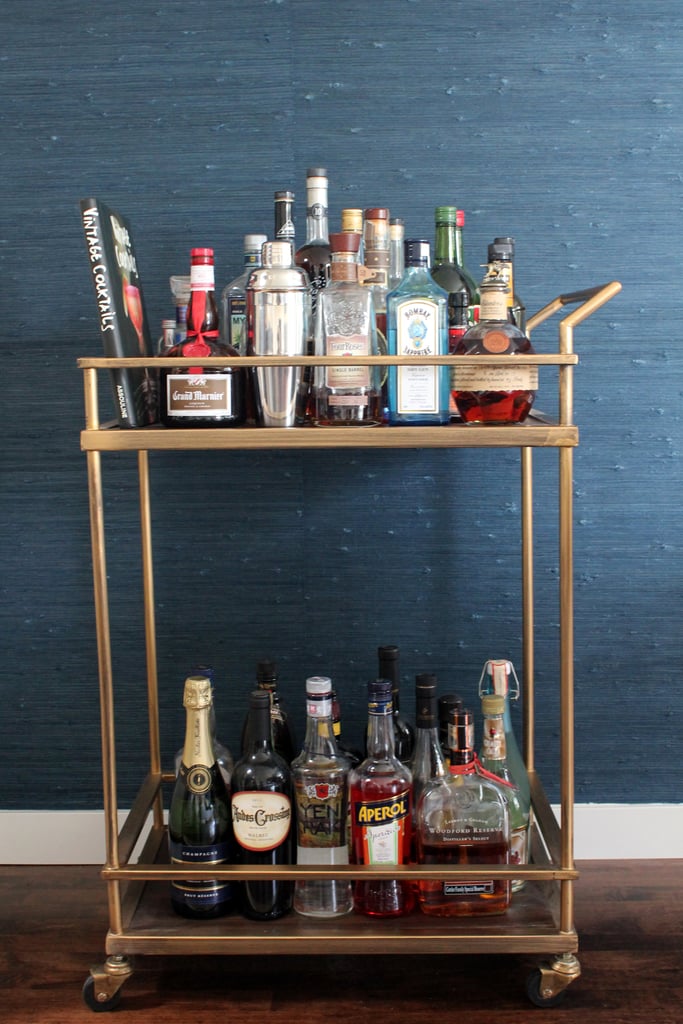 Image Source: POPSUGAR Photography / Lisette Mejia
Image Source: POPSUGAR Photography / Lisette Mejia
After greeting guests, the first
thing that you will want to do is offer them a drink. You don’t need to be full
service, but make sure you have the home bar basics covered.
Fresh Flowers
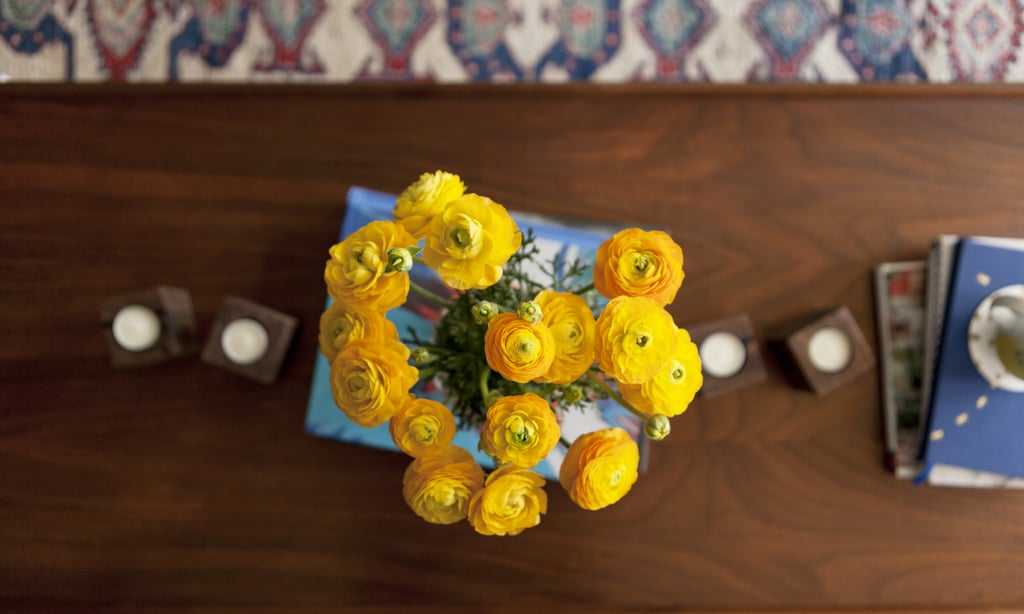 Image Source: POPSUGAR Photography / Mark Popovich
Image Source: POPSUGAR Photography / Mark Popovich
Flowers are the only decoration a
house really ever needs, no matter the occasion (although we feel pretty
strongly about candles too!). To get the most bang out of your buck, buy potted
flowers, like orchids. They may look delicate, but with proper care, they
will last for a month or longer.
The Lack of Clutter
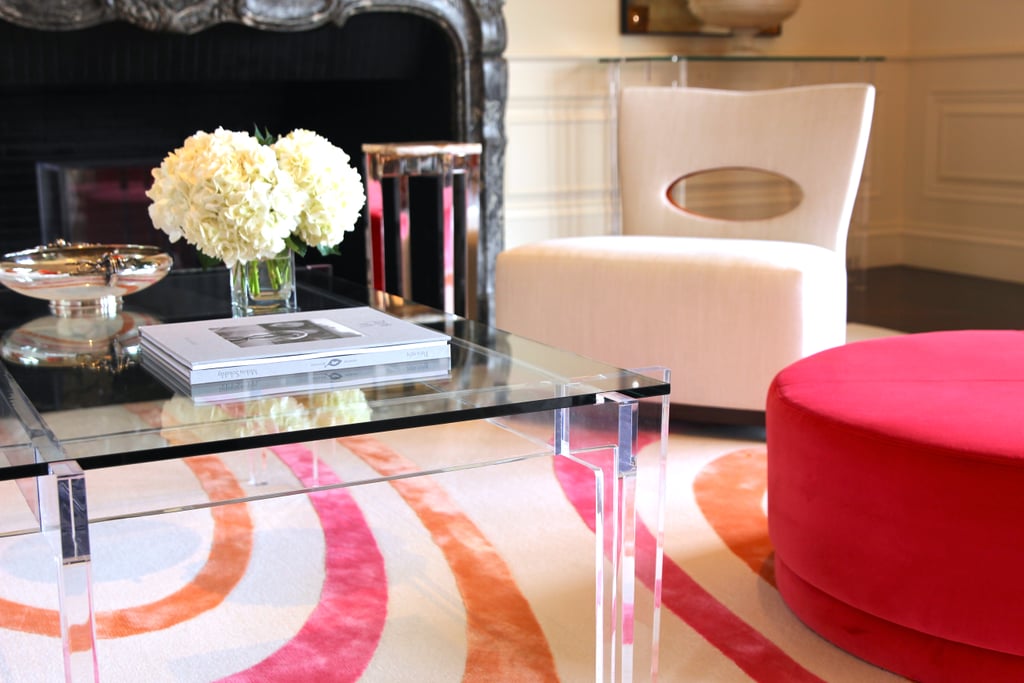 Image Source: POPSUGAR Photography / Grace Hitchcock
Image Source: POPSUGAR Photography / Grace Hitchcock
Even if you don’t have time to do a
deep cleaning, you can still organise your clutter. Get a tray or a set of
lidded boxes for each room and corral all the odds and ends — remotes,
keys, mail — in one place. Guests will feel relaxed in a space that
appears organised, even if it is just for show!
A Tidy Bathroom
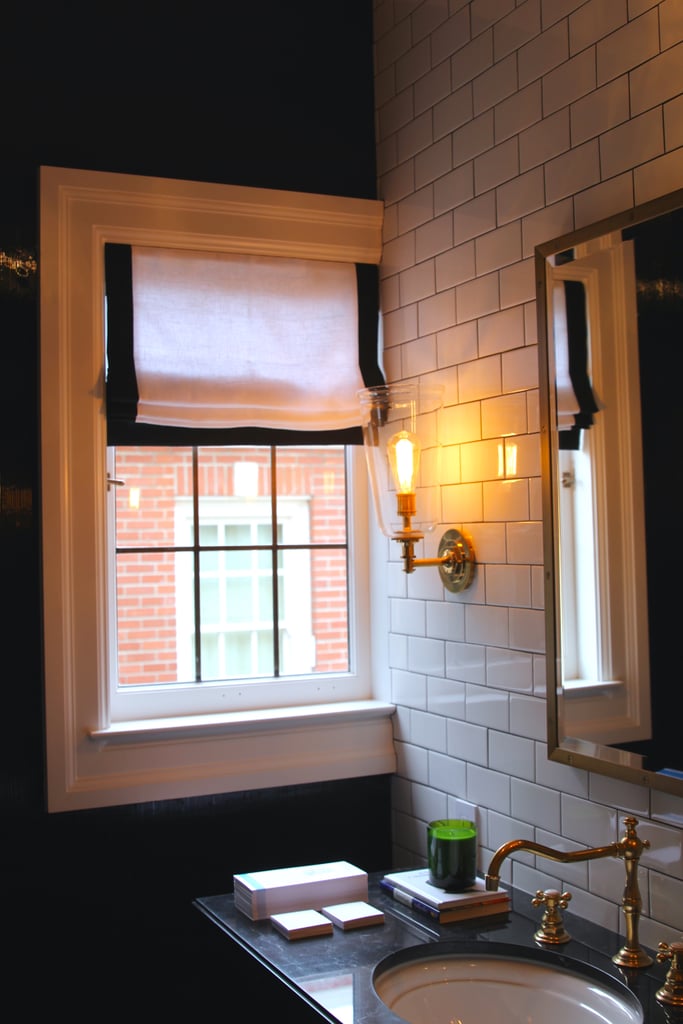 Image Source: POPSUGAR Photography / Grace Hitchcock
Image Source: POPSUGAR Photography / Grace Hitchcock
Before guests arrive, make sure your
bathroom has clean hand towels and enough toilet paper. Extra points for wiping
down surfaces and lighting a candle
An Organised Entryway

Image Source: POPSUGAR Photography / Lisette Mejia
Not only is it the first place and
last place that your guests will see, your entryway is also where they will be
dropping their coats and bags. Depending on how much room you have, add a coat
rack, umbrella stand, and a place to sit while taking shoes on or off.
Comments (0)
01 June 2018
By portermathewsblog
popsugar.com.au
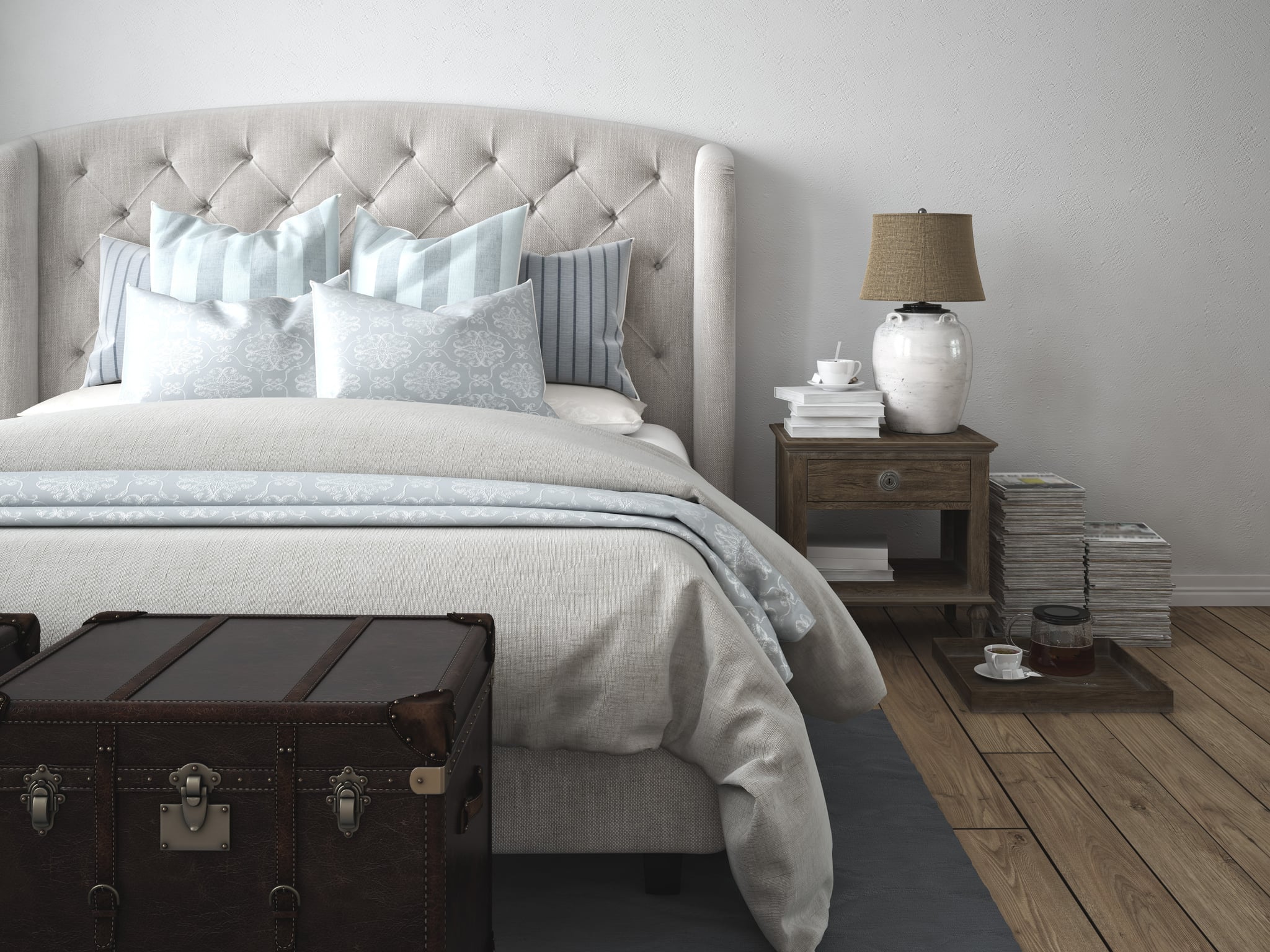
You’ve worked hard to make your bedroom a welcoming sanctuary, but beneath its pretty facade, there could be serious health hazards lurking. Read on to uncover the bedroom dangers that could be harming you while you sleep and learn what you can do about them.
Air Quality
Let your bedroom air out by opening the windows as weather permits each day. It will refresh the space and void it of noxious gasses that can build up indoors over time.
Not only will a potted plant or two beautify your bedroom, but they will also release oxygen and help filter out harmful compounds emitted by everyday cleaners, detergents, and fragrances. Studies show that these 10 houseplants can even improve your health.
A quiet air filterer is an efficient way to purify your bedroom of dangerous pollutants and agitating allergens like dust mites, pollen, and pet dander.
Cleanliness
Even with an air filter, it’s important to keep dirt and dust mites at bay by cleaning regularly. Pay special attention to areas that tend to accumulate them the most, including the floor, baseboards, windowsills, and upholstery. Even “clean” people often forget to wash these eight things.
The amount of dead skin, grime, and dust mites that collect on your bedding is rather horrifying and can cause problems from asthma to acne. The good news is it’s easy to get rid of by cleaning your sheets, duvet, and pillowcases every 1-2 weeks. Case in point? This horrific study reveals the horrific result of not washing your pillows for just two years.
Keep moisture from getting stuck in your bedding and mattress and causing problems by airing it out briefly before you make the bed in the morning. Pull back the sheets, fluff out the pillows, and give everything a few minutes to dry before they’re closed back up for the day.
Hidden Toxins
Bad news for memory foam pillow-lovers. These ergonomic head rests often outgas dangerous Volotile Organic Compounds or VOC’s that can cause headaches, nausea, and eye irritation. You don’t want your face, mouth, or nose anywhere near them. Swap them for pillows filled with organic materials, like wool or feathers, or at least a safer foam like a natural latex foam.
- Flame Retardant-Free Mattress
Considering how much time you spend in close proximity with your mattress each day, it’s a no-brainer to make it a safe one. While many products, including mattresses, were once doused in flame-retardant chemicals, it’s come to light that these chemicals are doing much more harm than good. They’ve been linked to types of cancer, birth defects, and fertility issues. Scary stuff, and reason to seek out an organic, chemical-free mattress.
In small apartment or studio, space is at a premium and spaces may have to do double duty – but do your best to keep office equipment away from your bed, especially if it’s running all the time. Research has shown that laser printers emit tiny particles into the air that may be dangerous.
Comments (0)
28 May 2018
By portermathewsblog
reiwa.com.au
 One of the most widely misunderstood elements of real estate is what condition a property should be in at settlement or possession.
One of the most widely misunderstood elements of real estate is what condition a property should be in at settlement or possession.
What does ‘buying as inspected’ really mean?
In short, a property is sold “as inspected”. If there was dust on a ceiling fan when you first inspected before contracting to buy then the fan can be dusty at settlement. The same goes for a dirty oven, a blown light globe or a squeaky laundry door. If it was dirty, blown or squeaky at inspection before purchase then so it should be at settlement.
Buyers will typically expect that the property is handed over to them spick n’ span and thankfully most house-proud sellers leave their homes in an appropriate condition when moving out, however legally there is no obligation for them to do so.
What should you expect at settlement?
If you’re buying a home, it’s smart to have a realistic expectation of what to expect at settlement.
Unless otherwise specified in the contract, the seller is under no obligation to have the property professionally cleaned for settlement and it is surprising how few buyers ask that such a condition be included.
The seller’s only obligation under the contract (Clause 6.1(b) 2 of the General Conditions) is to “…remove from the Property, before possession, all vehicles, rubbish and chattels, other than the Property Chattels.”
Many modern contracts to purchase include provision for essential plumbing, gas and electrical components to be working at settlement. Hence, if at settlement the toilet cistern leaks then the seller ought to make good because the contract says so.
It is trickier when, for example, a telephone jack doesn’t work at settlement. It is not strictly electrical but it is probably reasonable for a buyer to assume that it was functioning at inspection. This is partly because, caveat emptor (buyer beware) has all but disappeared according to some legal practitioners. The onus is probably on the seller to disclose (in this case) that the telephone jack didn’t work.
How to ensure you’re happy with the property at settlement
My view is that buyers need to take reasonable steps to ensure the property they have bought will be presented to them in a condition they are satisfied with.
This can be achieved by either contracting with the seller to guarantee it and/or being more thorough when inspecting the property in the first instance. Ask the agent if it’s ok to turn on taps, flush loos, flick switches, open and close doors, open the oven, turn on the dishwasher and so on before making an offer to purchase.
Buyers ought to have a realistic expectation of what to expect at settlement when buying an established home and acknowledge that opinions of presentation are subjective.
Speak to our market experts on 9475 9622 to discuss about your property concerns
Comments (0)
21 May 2018
By portermathewsblog
via popsugar.com.au
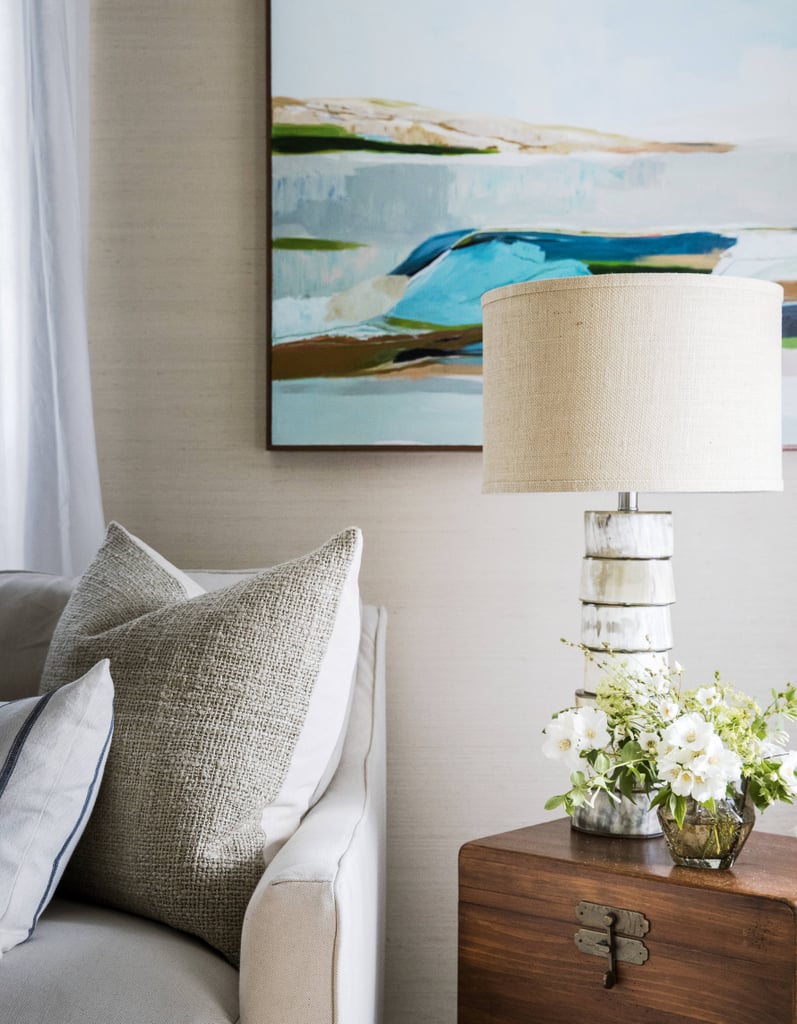 Image Source: Thomas J. Story/Sunset Publishing Corp
Image Source: Thomas J. Story/Sunset Publishing Corp
An old home with a lack of square metres might feel limiting to some, but the 83-square-metre, 1900s-era Sunset Smart Cottage proves any space can be transformed with strategic decorating and innovative home gadgets. Even the interior design concept for the cottage involved an emerging tech trend: virtual interior design services. Sunset tapped designers Jessica McCarthy and Emily Gaydon from Decorist, a virtual decorating service that offers a fresh approach to the design and remodelling process. “Online services such as Decorist are often budget friendly and more accessible to the masses. We liked the idea that users can get matched up with designers based on their personal style and goals and can work through the process over email, FaceTime, and even texts,” says Sunset home editor Chantal Lamers.
So what exactly was the design strategy behind this tiny tech oasis? POPSUGAR caught up with Decorist designer Jessica McCarthy to get her insights on the smartest solutions for living large in a small home. Read on to discover the optical illusions and space-planning secrets she used in every room!
- A Bold First Impression

Image Source: Thomas J. Story/Sunset Publishing Corp
Even the tiniest cottage can have major curb appeal. Jessica suggests painting your front door in a bold hue and replacing the exterior hardware. The cost-effective upgrades are details guests will definitely notice. Keep landscaping affordable and low-maintenance by planting drought-friendly shrubs and perennials from the Sunset Western Garden Collection. Top off the look by adding a few potted plants to the porch for an extra touch of greenery.
- Layered Textures
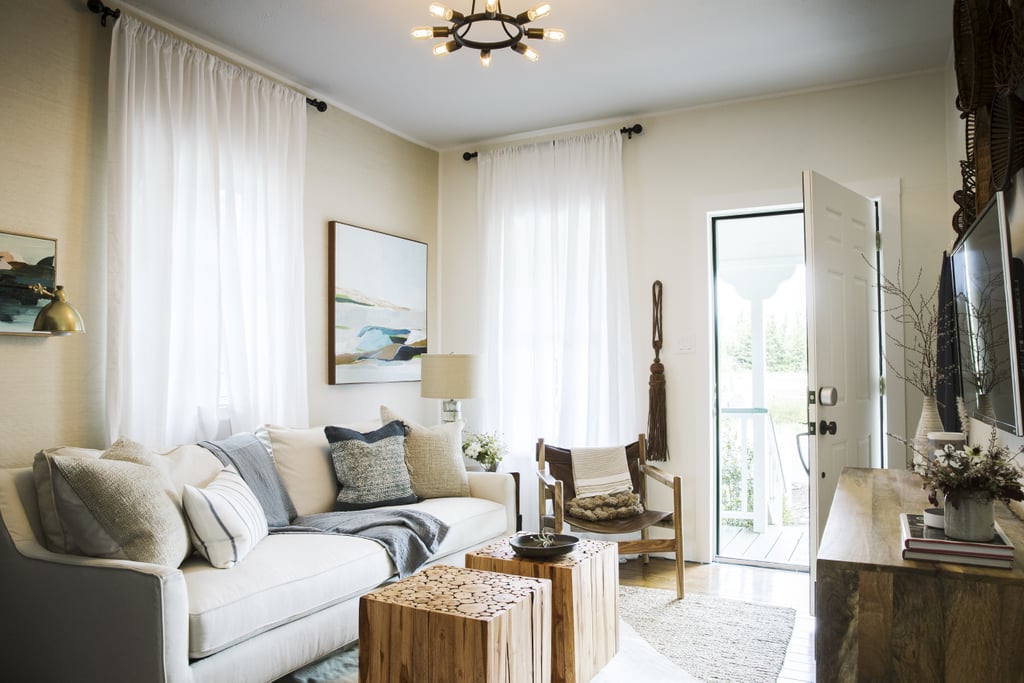
Image Source: Thomas J. Story/Sunset Publishing Corp
To combat the claustrophobic feel of a narrow living room, Jessica suggests opting for a neutral colour palette and avoiding bold patterns to make the room feel large and airy. Since colour and pattern take a backseat, you can go wild with texture. Grasscloth wallpaper, leather seating, linen curtains, and a variety of throw pillows give the space a rich, layered feel. To complete the look, add a semi-flushmount instead of a hanging pendant or chandelier to make the ceilings feel even taller and hang curtains as high as possible.
-
A Discreet Media Station
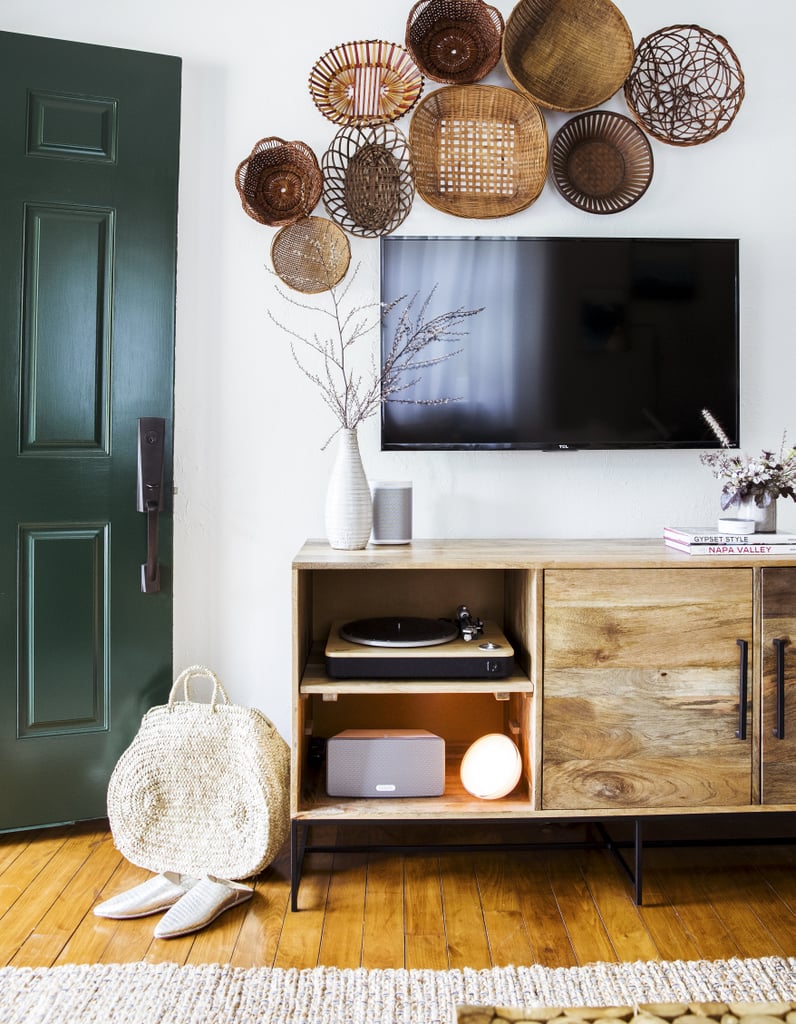
Image Source: Thomas J. Story/Sunset Publishing Corp
Take advantage of precious wall space by creating a media station that is discreet and beautiful. Jessica suggests thinking outside of the gallery wall box by incorporating gorgeous baskets instead of framed art to distract from the floating TV screen. Keeping baskets in the same colour family is Jessica’s trick for achieving a clean and uncluttered vibe.
- Stylish Storage
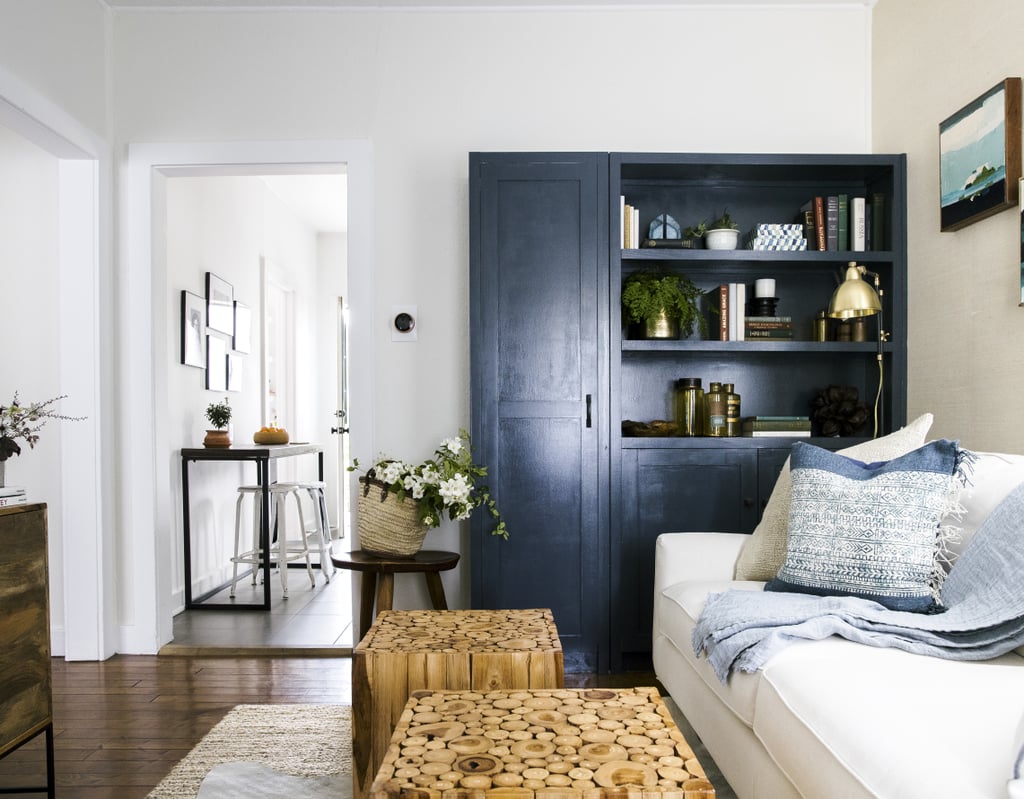
Image Source: Thomas J. Story/Sunset Publishing Corp
While Jessica wanted to keep the colour minimal, she used an accent colour throughout the house for fluidity. In this case, a custom-built cabinet in navy ties in with the sofa pillows and kitchen, but it also conceals clutter behind cabinets and displays beautiful objects on shelves.
- A Mini Breakfast Nook
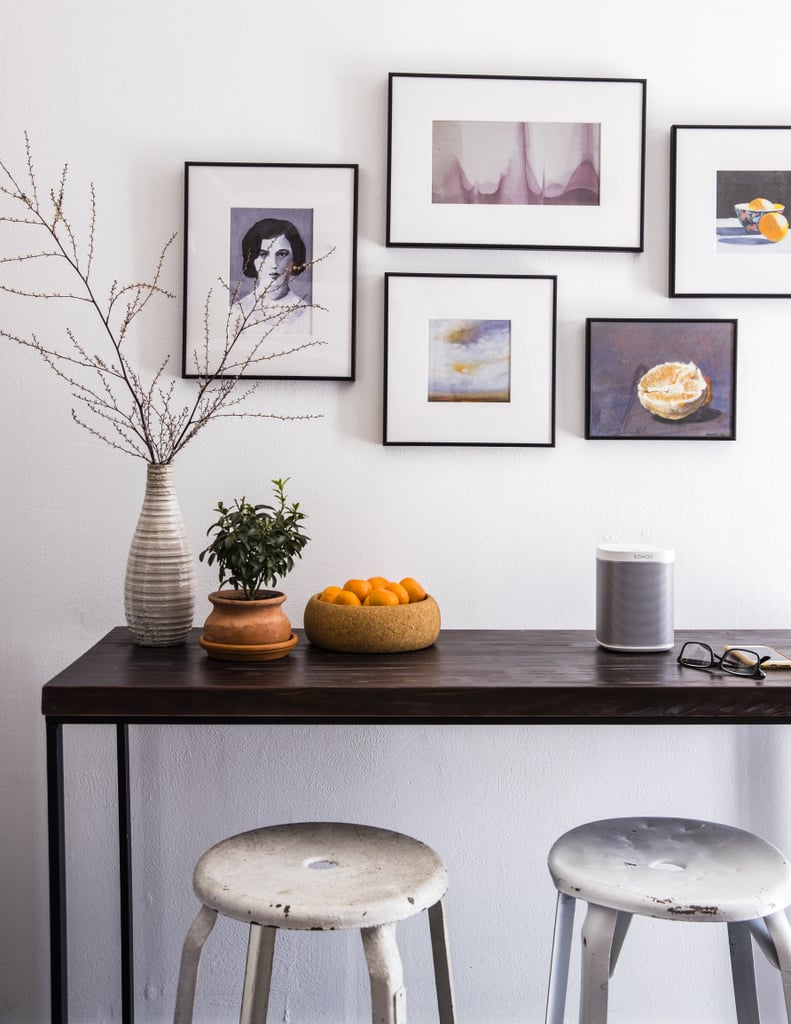
Image Source: Thomas J. Story/Sunset Publishing Corp
Just because you have a small kitchen doesn’t mean you can’t eat in it. Jessica loves the idea of pushing a narrow console against a wall and adding bar stools for a makeshift dining nook.
-
Open Shelves
 Image Source: Thomas J. Story/Sunset Publishing Corp
Image Source: Thomas J. Story/Sunset Publishing Corp
Eliminating upper cabinets can visually expand a small kitchen. Jessica leveraged the brightening power of counter-to-ceiling white subway tiles paired with white floating shelves for an airy and undeniably stylish effect. If a remodel isn’t in the works, Jessica suggests painting cabinets and installing new hardware for a customised look.
- Plug-In Sconces
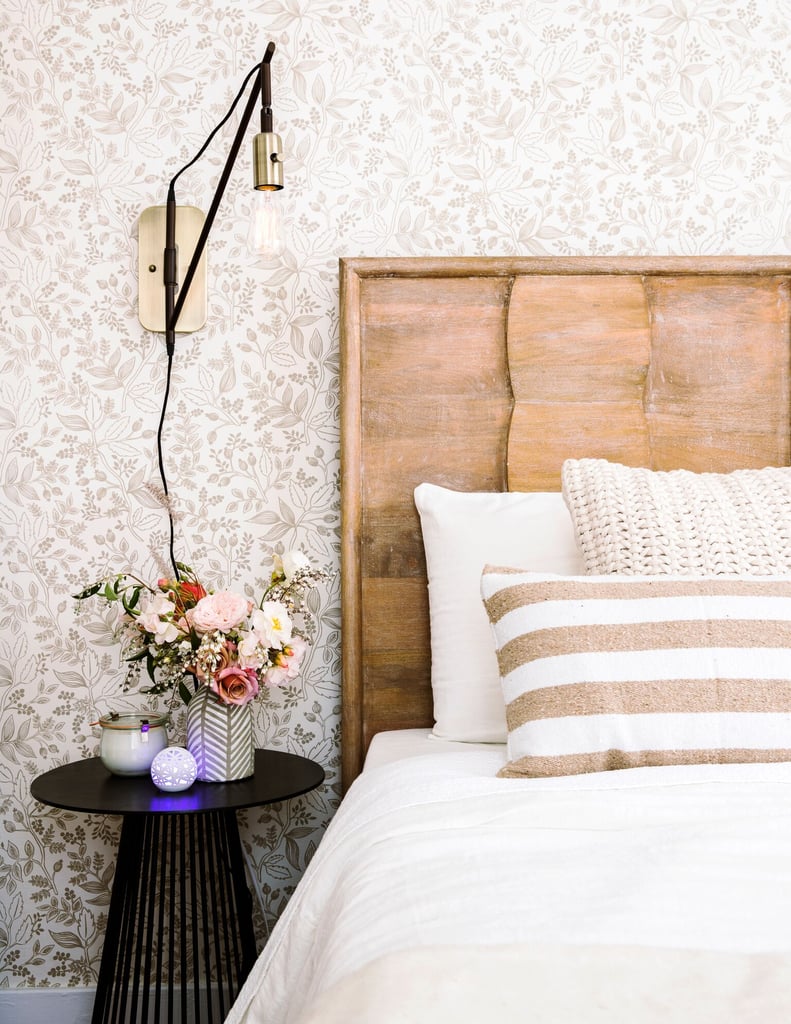
Image Source: Thomas J. Story/Sunset Publishing Corp
If spacious nightstands aren’t in the cards, swap in petite side tables and free up table space by installing plug-in sconces that don’t require expensive or permanent electrical work.
- A Calm Colour Palette
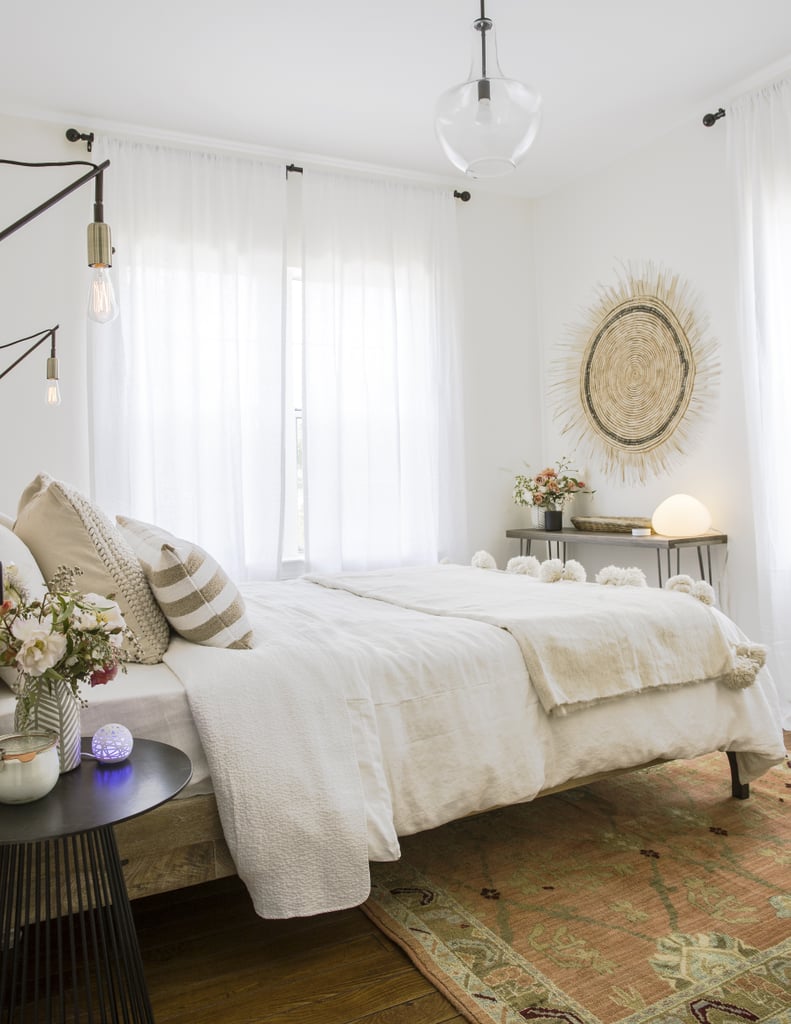
Image Source: Thomas J. Story/Sunset Publishing Corp
Like the living room, the bedroom also follows suit with a calming colour palette. Jessica chose a single tone and explored a range of shades on the walls, bedding, rug, and accent decor.
- Statement Art
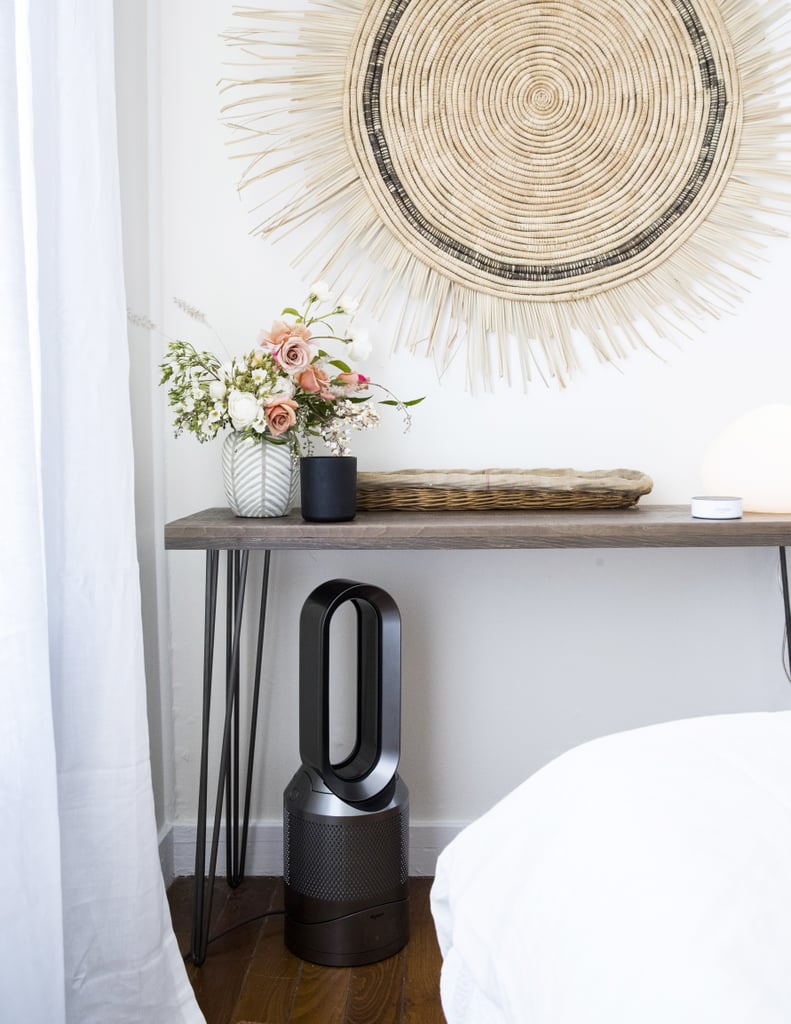
Image Source: Thomas J. Story/Sunset Publishing Corp
Small bedrooms don’t necessarily require diminutive art. In fact, Jessica recommends doing the exact opposite by hanging large baskets, textural pieces, vintage finds from travels, and oversize prints to really make a statement.
- Well-Utilised Corners
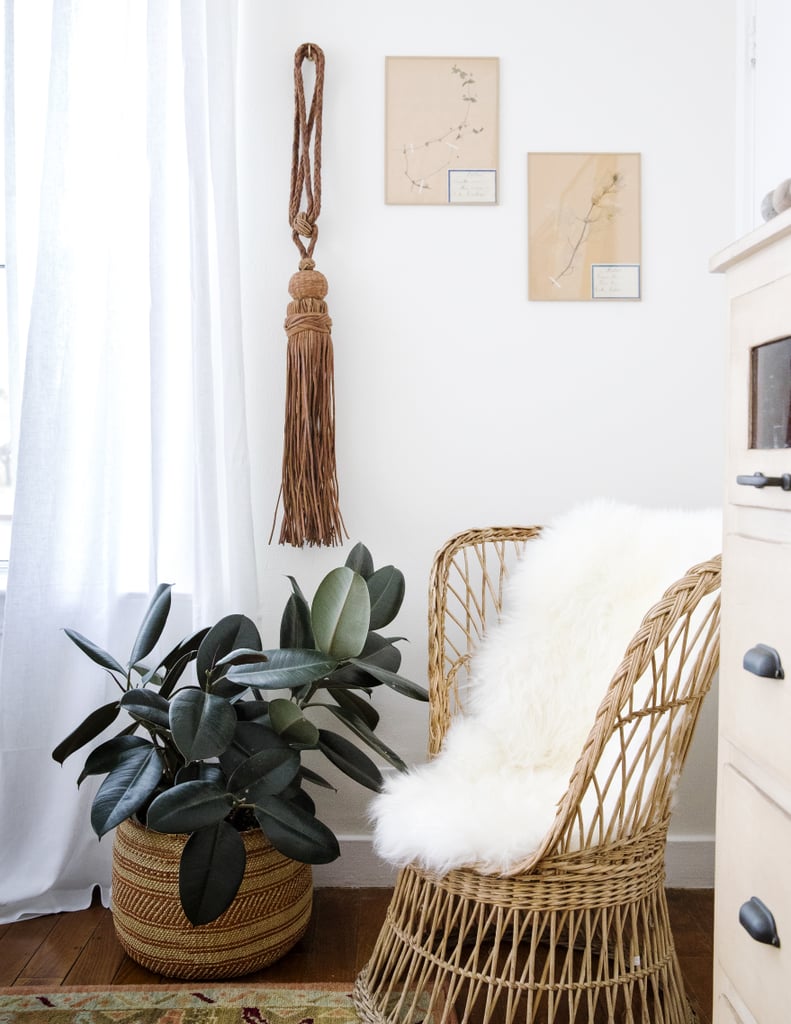
Image Source: Thomas J. Story/Sunset Publishing Corp
To make a big design impact in a corner of the room, mix pieces with varying textures. Jessica especially likes the way the leather wall object, wicker chair, and fur throw create a cosy effect that feels curated.
- A Modern Murphy Bed
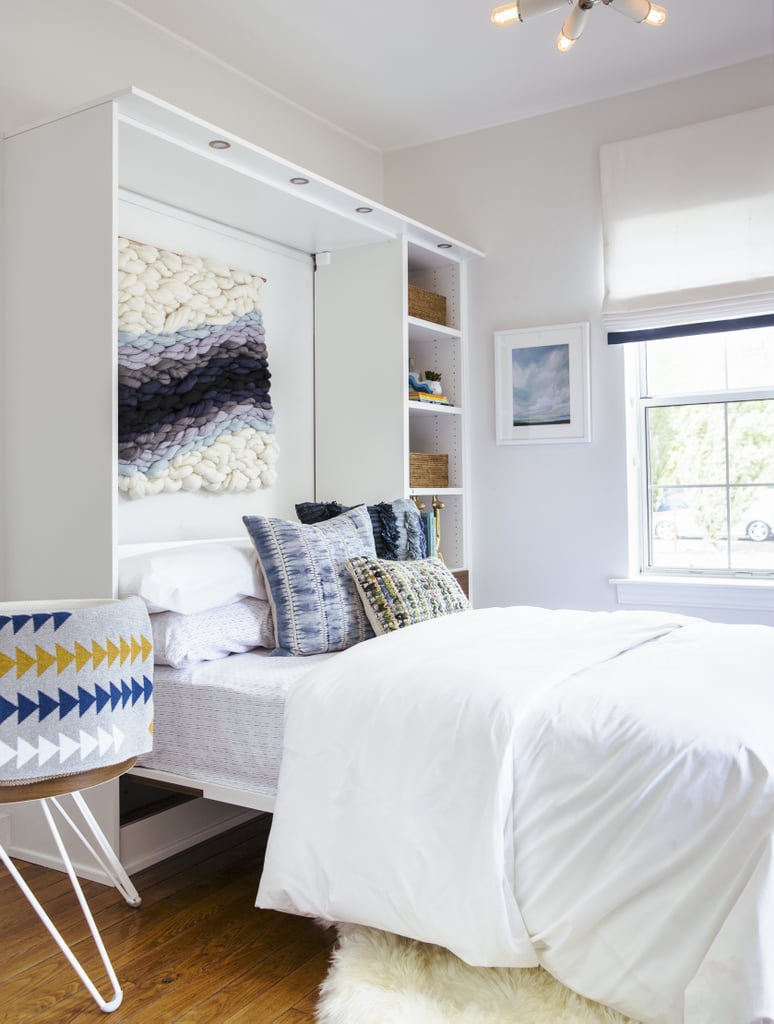
Image Source: Thomas J. Story/Sunset Publishing Corp
A murphy bed can be the perfect solution for children’s rooms that require space to play or a guest room that can double as an office. Jessica likes the idea of hanging something dramatic but soft above the bed, like the woven wall art. The texture adds interest but won’t break or budge when the bed is closed.
-
Customised Closets
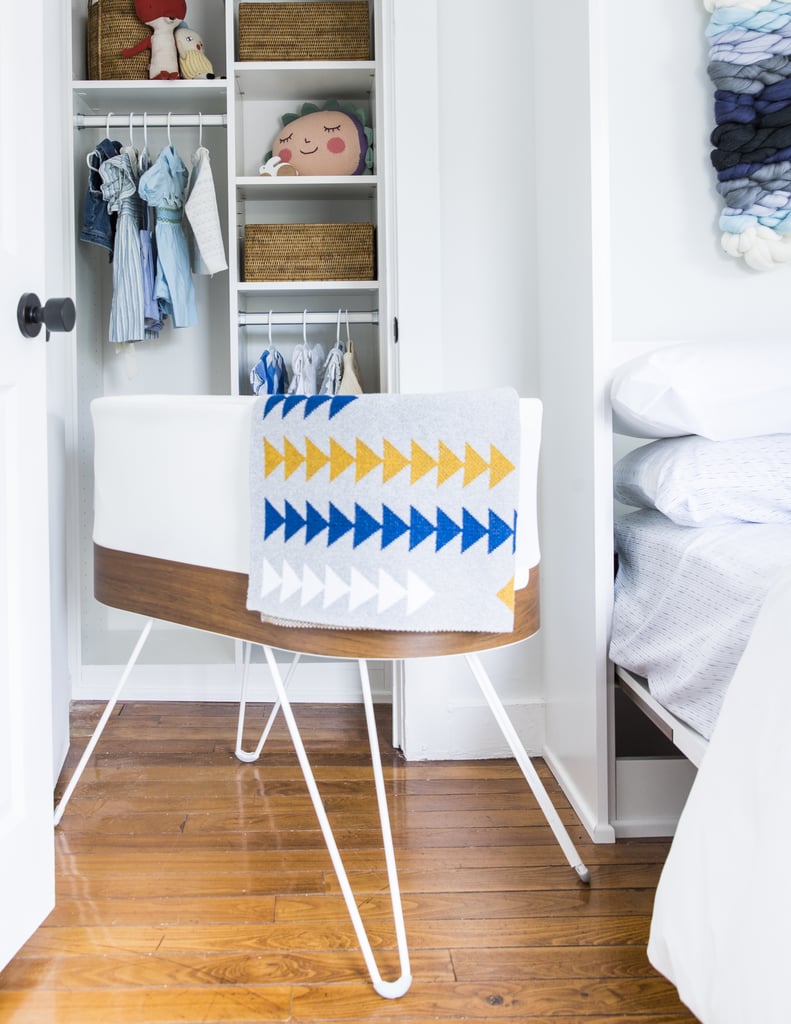 Image Source: Thomas J. Story/Sunset Publishing Corp
Image Source: Thomas J. Story/Sunset Publishing Corp
Katy Milton of California Closets designed the built-in cabinetry to make the most out of a tiny closet. Jessica recommends adding baskets and bins to cleverly conceal clutter while keeping things in order.
-
Multitasking Work Space
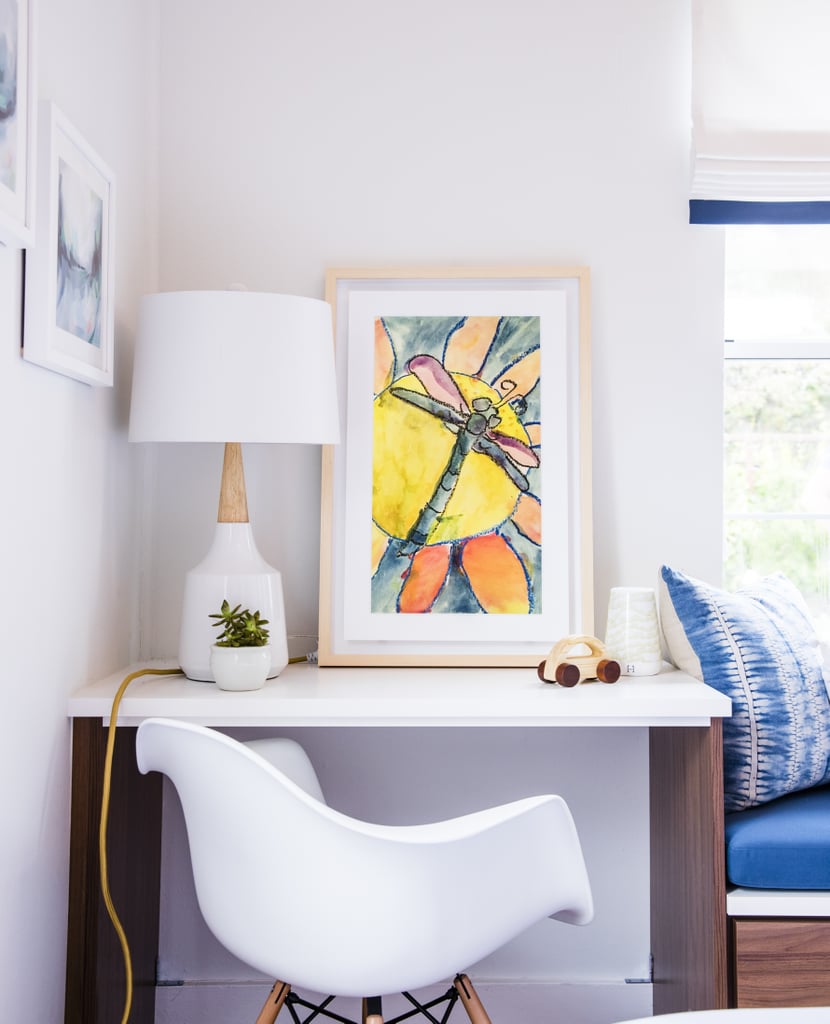
Image Source: Thomas J. Story/Sunset Publishing Corp
Multifunctional pieces like a small desk, which can be used as an extra table surface for displaying decor, doing homework, and being creative, are one of Jessica’s favourite small-room staples. If you have multiple pieces of children’s art or a group of family photos without the space to hang them, consider investing in the Meural. It’s a digital canvas that gives you instant access to over 30,000 works of art, but which also allows you to upload your child’s drawings and rotate between images.
- Wall Storage
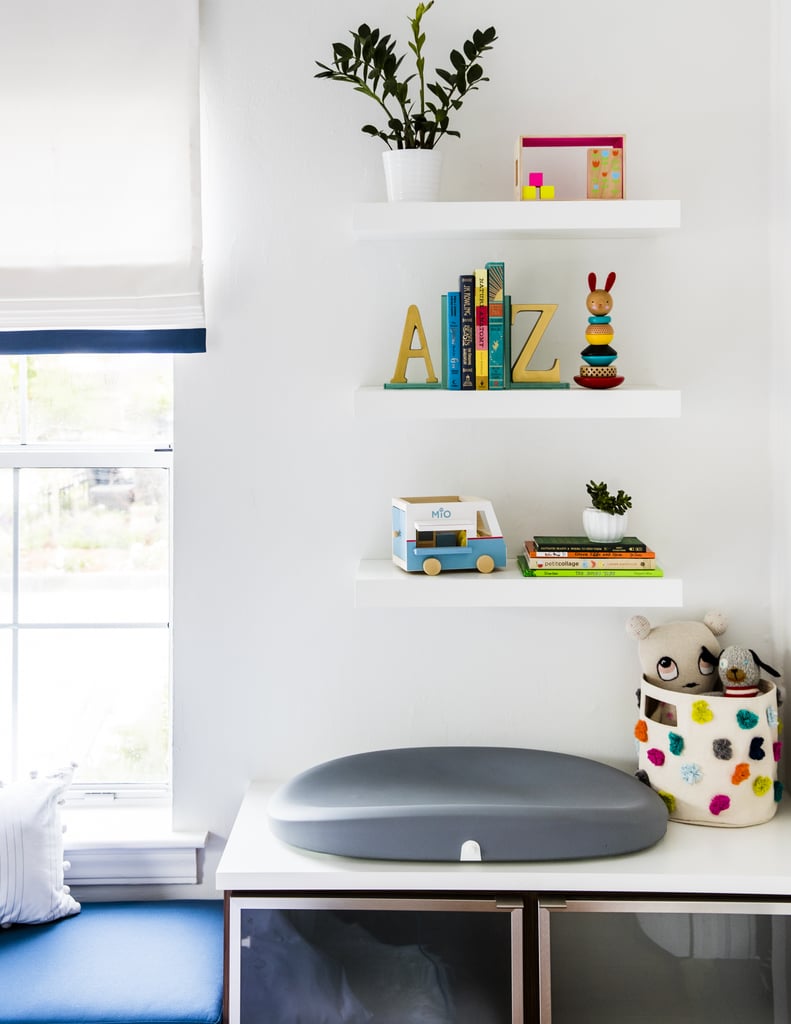
Image Source: Thomas J. Story/Sunset Publishing Corp
Jessica believes shelving can double as eye candy when you mix in your favorite artwork and accessories.
- Minimal Accessories
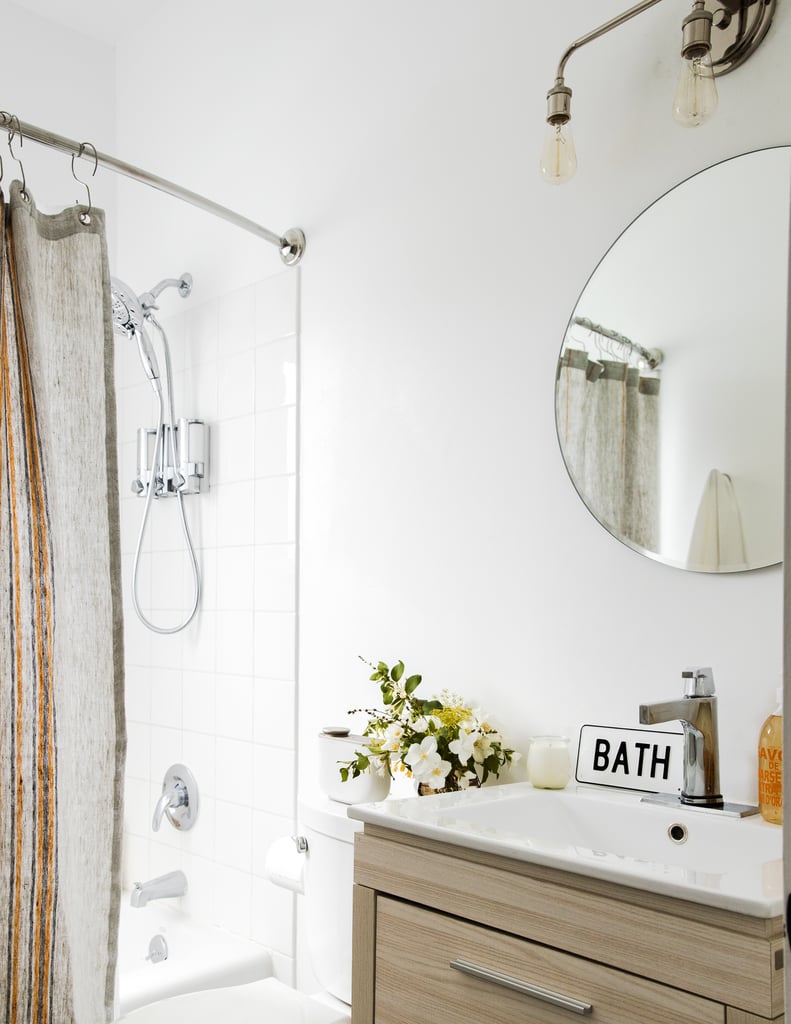
Image Source: Thomas J. Story/Sunset Publishing Corp
Create the illusion of more square footage by selecting the right colour palette and working in some cosmetic details. Jessica likes to use large mirrors and extra layers of lighting with sconces to make the space appear larger. Keeping the space clutter-free and minimally accessorised is another tricks she recommends for small bathrooms.
-
Small-Scale Patio Furniture

Image Source: Thomas J. Story/Sunset Publishing Corp
If you don’t have room for an outdoor sofa or settee, consider using an Adirondack chair with a foot stool that can be moved. Pair it with a small table and you have the basic comforts needed for lounging
Comments (0)